
10 unforgettable things to do in Kakadu National Park
Elizabeth Whitehead
Writer & Producer
30 October 2023
Before planning your trip to the Northern Territory, consider these amazing activities for your Kakadu bucket list….
Kakadu National Park is nearly one-third of Tasmania in size. So, feeling bewildered when it comes to choosing the best things to do in Kakadu is understandable. The National Park is dual-listed by UNESCO as a World Heritage site for its cultural and natural attributes – meaning there’s plenty here to explore. Below, we’ve rounded up a guide on the best things to do in Kakadu whether you’re a foodie, nature lover or a history buff.
It’s worth noting that to enter, you’ll need to purchase a Kakadu National Parks Pass, which can be organised online , or bought at one of the locations listed on the Parks’ website. But once that’s sorted, check out our pick for the best things to do in Kakadu.
1. Join a Yellow Water Billabong cruise
Best for: Families and wildlife lovers
The Yellow Water Billabong is Kakadu’s postcard shot: regular boats cruise across its great swathes of floodwaters, half-submerged paperbarks, pandanus and water lilies, while crocs cruise beneath. It’s no surprise this is one of Kakadu’s most popular things to see and do.
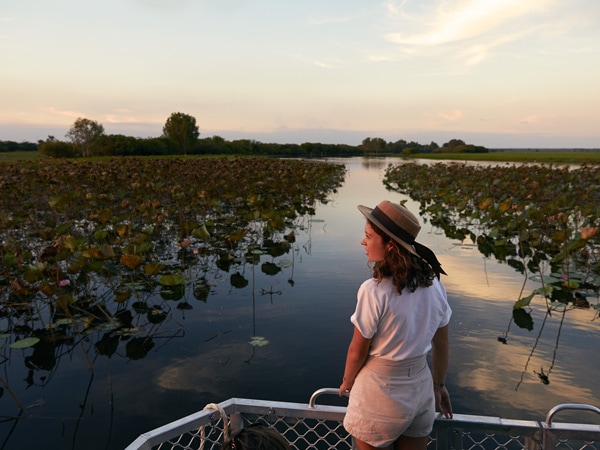
See waterlilies up close. (Image: Tourism NT/Matt Cherubino)
You can see many of Kakadu’s birds: jabiru, sea eagles, magpie geese and egrets. Cruises operate all year round; in the dry season, you can also explore the billabong on foot, via boardwalks.
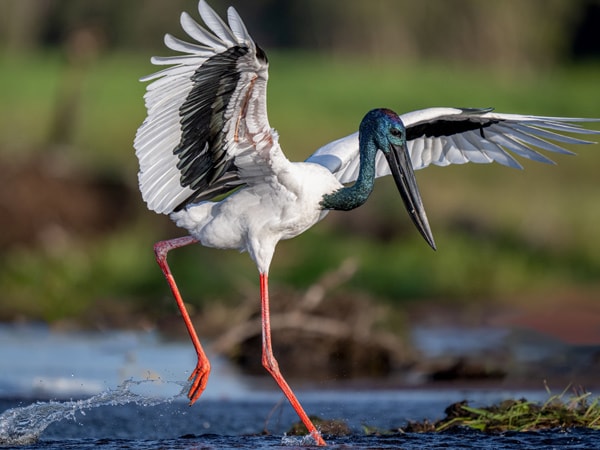
The impressive jabiru resides in Kakadu wetlands. (Image: NT/ Paul Thomsen)
If you’re after other cruises or tours in Kakadu, we’ve rounded up a guide to the best tours in Kakadu National Park.
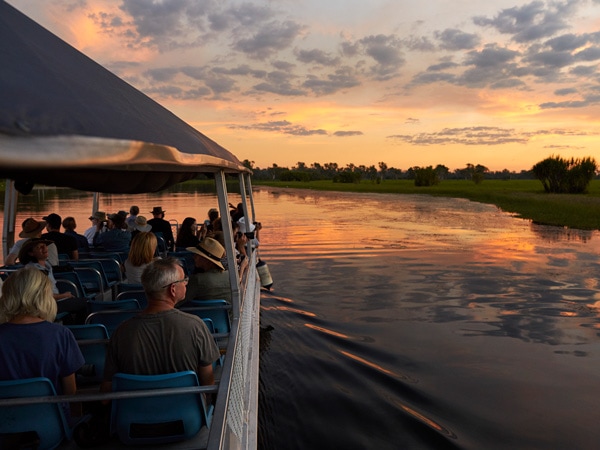
Soak up majestic sunset views during the Yellow Water Billabong Cruise. (Image: Tourism NT/Matt Cherubino)
Access information
Via 2WD in the dry (you can drive virtually up to the boat ramp); in the wet, you simply drive to the nearby hotel and hub Cooinda Lodge and hop on a shuttle bus.
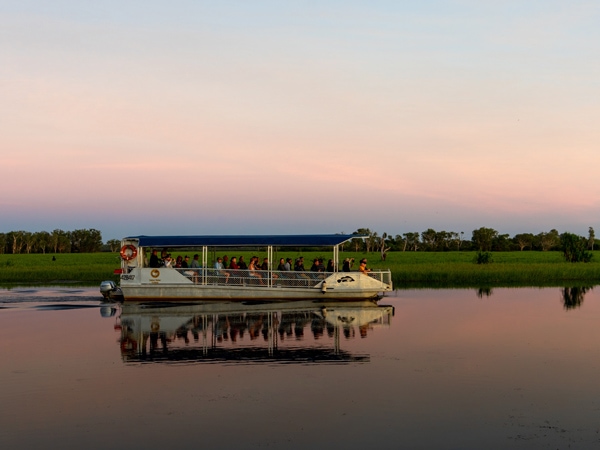
Hop on a Yellow Water Billabong cruise. (Image: Tourism NT/Bronte Stephens)
2. Watch the sunset at Nawurlandja Lookout
Best for: Travellers seeking serene vistas or photographers looking for a postcard-perfect shot
Nawurlandja lookout attracts locals, visitors and snap-happy photographers during golden hour, seeking the best vantage point to admire the surrounding rock formations as the escarpment starts to glow while the sun sets behind the vista.
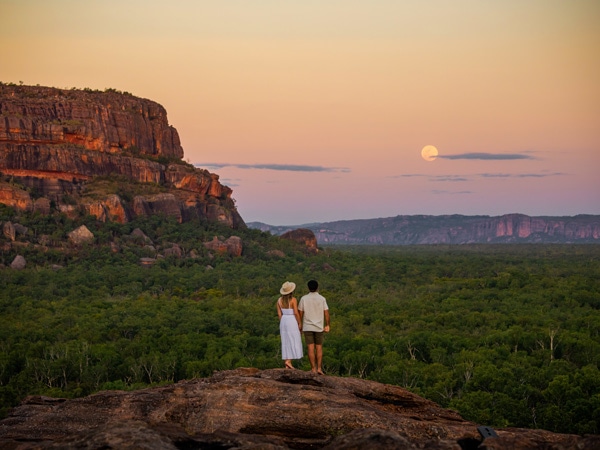
Take in breathtaking sights from Nawurlandja Lookout. (Image: Tourism NT/Kyle Hunter & Hayley Anderson)
Walk up the 300-metre incline for sweeping views over Anbangbang Billabong and towards Arnhem Land . Have your camera ready, this is one of the most picturesque spots in the park, especially when the sun starts to set.
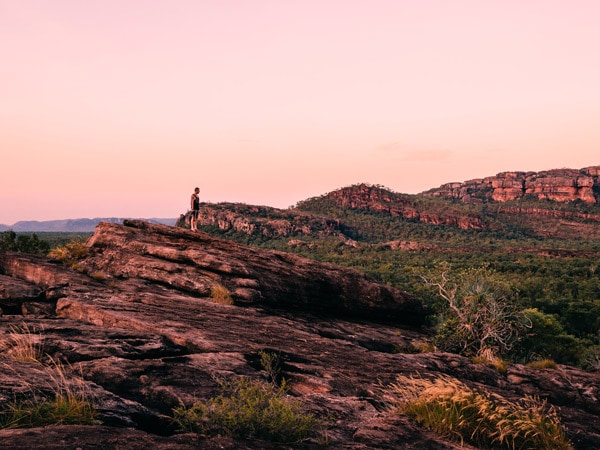
Hike up the rocky and rugged plains of Nawurlandja. (Image: Tourism NT/Jewels Lynch)
3. Swim at Maguk
Best for: Active and adventurous traveller seeking off-the-beaten-path experiences
Of all the things to do in Kakadu, a swim at Maguk is one of the more under-the-radar activities, despite being absolutely stunning. It’s only an hour’s drive south of Cooinda Lodge (one of Kakadu’s popular accommodation options ), but you’ll need to turn off the sealed highway and drive a 14-kilometre, 4WD-only track, then walk a kilometre to get here.
The effort required makes this one of the Park’s lesser-visited natural plunge pools, but it’s gorgeous to swim in, and the walk-in, via a beautiful creek and classic pandanus forest, is truly lovely. A short but steep climb will get you to the top of its waterfall, where more pools await you.
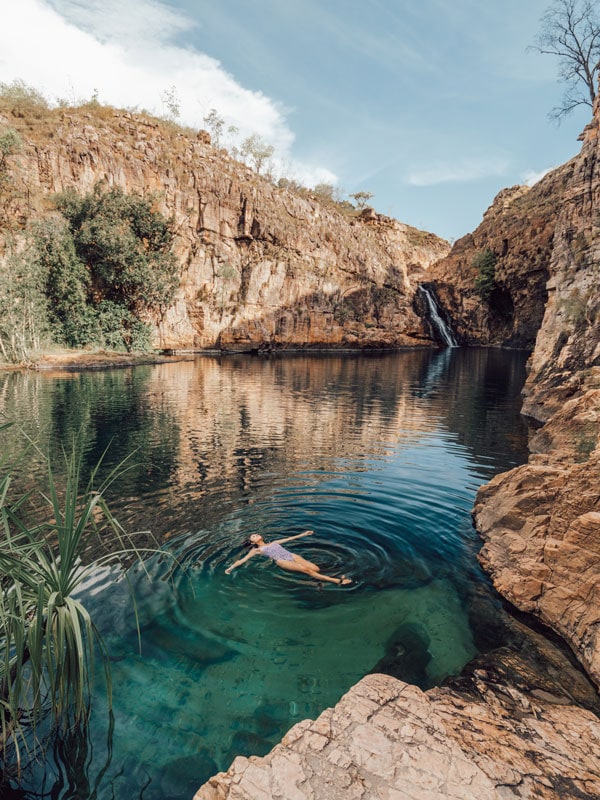
Relax on the refreshing waters of Barramundi Gorge (Maguk). (Image: Tourism NT/Adriana Alvarado)
Via 4WD in the dry; then it’s a two-kilometre, easy-to-moderate, return walk. Maguk is inaccessible in the wet.
4. Admire Kakadu rock art at Ubirr
Best For: Anyone curious about local culture
Ubirr is one of the most famous rock art sites in Kakadu . A kilometre-long circular walk from the car park takes in the Main Gallery, the Namarrgarn Sisters Gallery and the Rainbow Serpent Gallery, with the dates of art ranging from over 15,000 years old to as recent as 150 years ago.
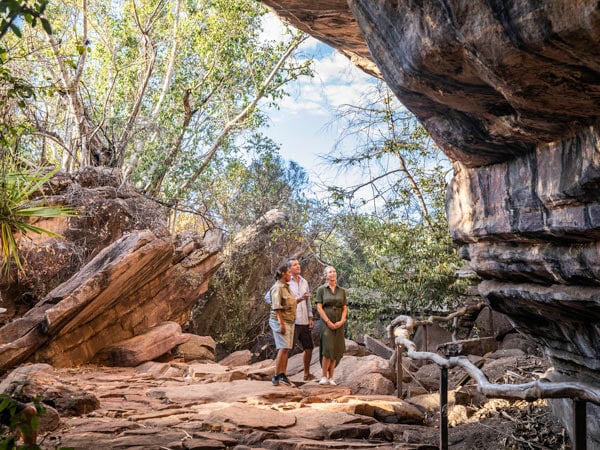
Join a cultural walk tour to Ubirr. (Image: Tourism NT/Helen Orr)
A visit to Kakadu’s rock art is one of the most educational things to do if you’re interested in Indigenous culture. You’ll witness ‘X-ray’ style paintings of animals and figures from Dreamtime folklore.
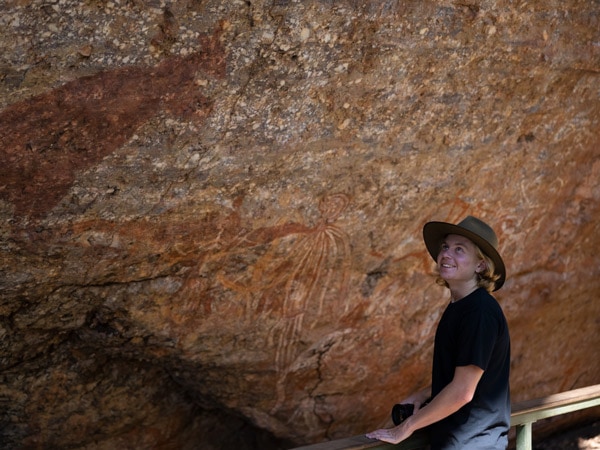
Learn about the Ubirr rock art in Kakadu. (Image: Tourism Australia)
Make sure you take the extra 30-minute moderate climb to Nardab Lookout for excellent sunset views.
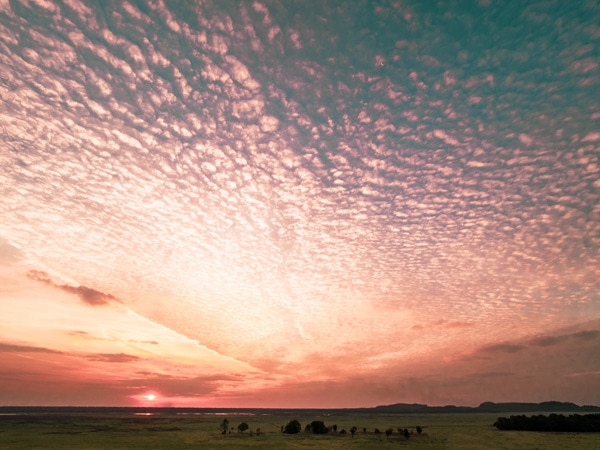
Pastel hues are majestically draped over the sky. (Image: Tourism NT/Jewels Lynch)
Via 2WD in the dry (though check road conditions early in the season). The circular track is partly wheelchair accessible. In the wet, only 4WDs can drive here; if 4WD access is also closed due to flooding, you might be lucky enough to access the site via boat, on a wet season Guluyambi Cultural Cruise.
5. See the famous Burrungkuy (Nourlangie) rock art
Best for: Anyone curious about local culture
The second of Kakadu’s most famous rock art sites, the well-preserved area of Burrungkuy (Nourlangie) offers spectacular views and a fascinating window into local Aboriginal culture. You’ll need 90–120 minutes to tour the multiple art sites, along a 1.5-kilometre circular walk that also includes the Anbangbang Shelter, providing refuge from the weather for 20,000 years for locals who whiled away the time by decorating the walls with their stories.
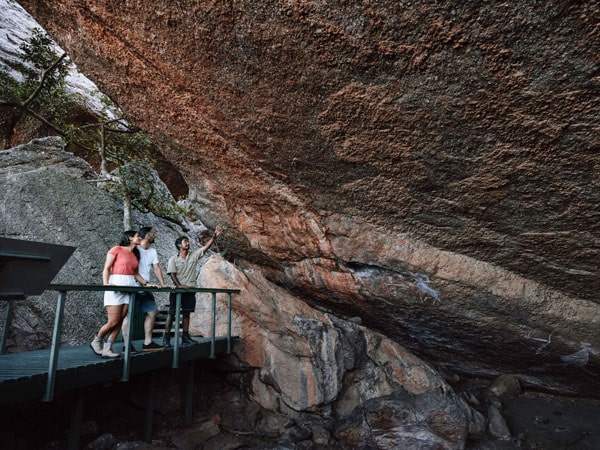
Seeing the World Heritage-listed Nourlangie Rock Art up close is a powerful experience. (Image: Tourism NT/Shaana McNaught)
If you want to enrich your knowledge and experience of Kakadu’s rock art, Yibekka Rock Art Tours is a fantastic local offering. Their Indigenous guides lead tours to Burrungkuy, sharing the incredible stories behind the rock art and the Dreaming stories held within the landscape.
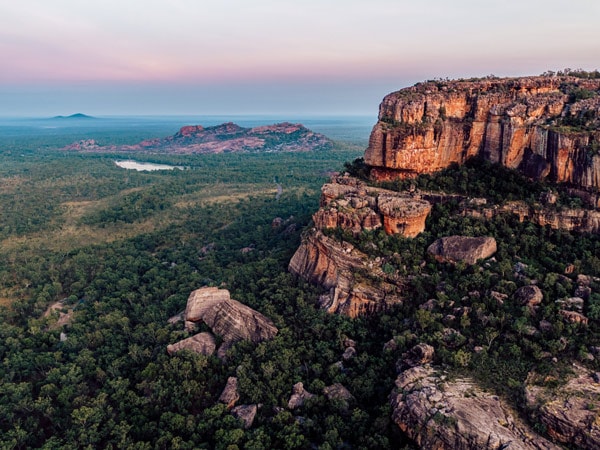
Nourlangie is one of Kakadu’s most famous rock art sites. (Image: Tourism Australia)
Via 2WD, year-round. The 1.5-kilometre walk is easy; the 600-metre climb to the lookout is moderately steep.
6. Check out Jim Jim Falls and Twin Falls
Best for: Travellers seeking a swim and some show-stopping scenery
No visit is complete without seeing Kakadu’s beautiful waterfalls – they’re key to the massive movement of water that marks the seasons . However close to each other geographically, they’re actually very different. Jim Jim Falls features vertiginous 150-metre-high cliffs surrounding a beautiful, deep plunge pool, and flows only after the wet season.
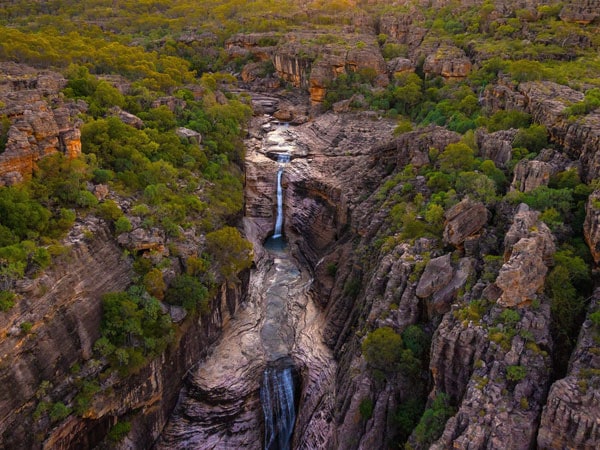
Jim Jim Falls looks stunning from above. (Image: Tourism Australia)
You can swim there in the top pool during the dry season and admire the unexpected presence of silica sand – this area was once an inland sea. Kakadu’s Twin Falls are in spectacular flow all year round, continuously gushing over a 220-metre drop onto the beach below.
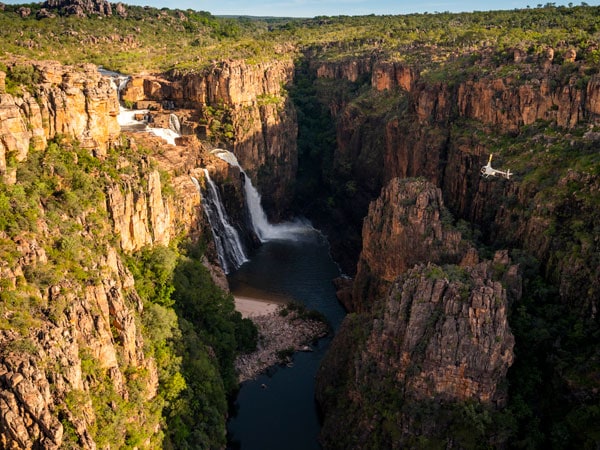
Appreciate the stunning beauty of Twin Falls. (Image: Tourism NT)
Twin Falls has a very pretty plunge pool, but you can’t swim here; saltwater crocodiles do occasionally make their home here. The plateau above it is safe for swimming, though, and well worth the hike up.
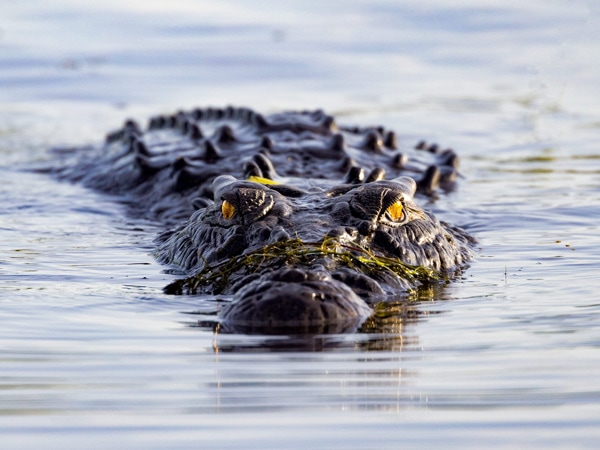
Spot saltwater crocodiles within Kakadu National Park. (Image: Tourism Australia)
You can get to Jim Jim Falls via 4WD in the dry season. From the car park, take a moderately difficult 45-minute walk over boulders to the top plunge pool where you can swim. To get to Twin Falls you’ll need a snorkel on your vehicle to get through a 0.8-metre water crossing. You then board a shuttle boat from the car park, which takes you up the gorge, before a short walk to the falls themselves.
7. Take one of the Yurmikmik Walks
Best for: Nature lovers and travellers looking to get active
The Yurmikmik walks are a series of interconnected trails exploring the wilds of the park’s southern region, and they are underutilised, underrated, local favourites. These trails are especially beautiful during the wet season, when the landscape becomes lush with greenery. You’ll also likely spot an abundance of wildlife, from wallaroos to cockatoos and finches.
The two-kilometre-return Boulder Creek Walk runs through monsoon forest and woodlands; the five-kilometre return walk to Yurmikmik Lookout takes you to the ridge for fantastic views over Yurmikmik country (pack your camera).
The 7.5-kilometre return Motor Car Falls Walk journeys along a historical track through to shady creeks and rainforest; and the ultimate Kakadu walking experience, is the 14-kilometre overnight Motor Car and Kurrundie Creek circuit, with some sections best navigated by GPS and compass (you’ll need a permit to camp here).
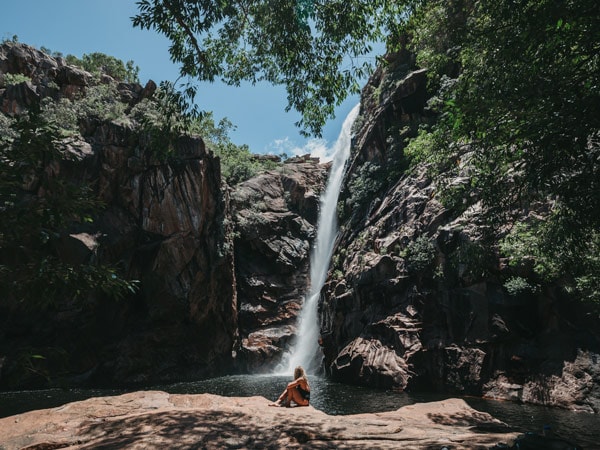
Take a refreshing dip at Motor Car Falls. (Image: Tourism NT/Jarrad Seng)
Via 4WD year-round. The area may be closed due to flooding in the wet.
8. Visit Mamukala Wetlands
Best for: Nature lovers and birdwatching enthusiasts
A hugely important part of Kakadu is its birdlife, and Mamukala has a bird hide shelter where you can have some quiet time and really enjoy the sight of thousands of magpie geese (particularly from September–October) coming together to feed, undisturbed.
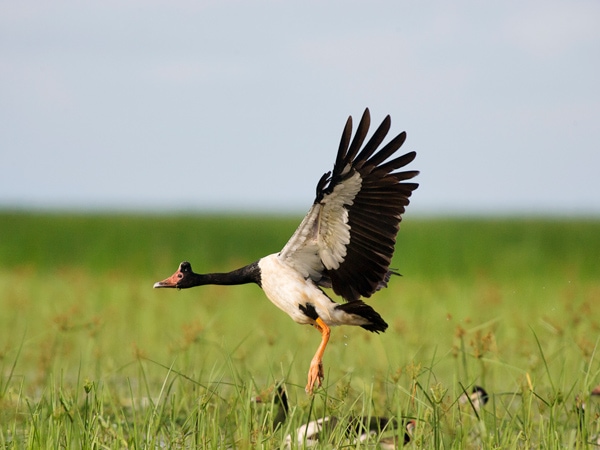
Visitors flick to Kakadu to admire the birdlife, including magpie geese. (Image: Bamurru Plains)
Take a self-guided tour on the nearby walks, ranging from one to four kilometres; the three-kilometre walk alongside the wetlands is ideal to enjoy the paperbarks, pandanus and water lilies. Beautiful and accessible for most of the year, it’s most dramatic in the late wet season when birds congregate in their thousands.
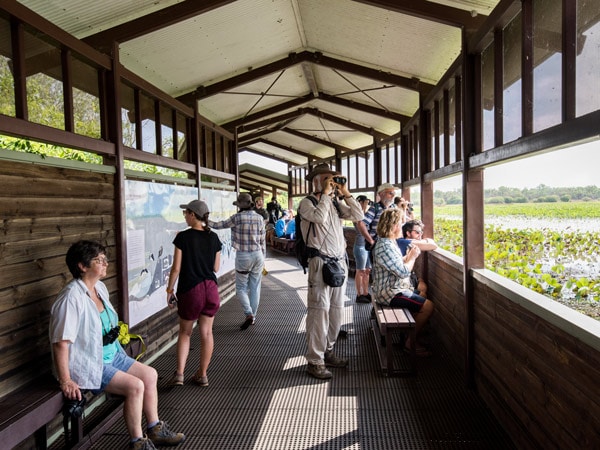
Birdwatchers gather at the Kakadu Bird Week. (Image: Tourism NT/Navin Chandr)
Via 2WD year-round, although the area may be closed due to flooding in the wet. The bird hide is accessible by wheelchair, 500-metre return; the three-kilometre loop walk is rated easy.
9. Kakadu Full Moon Feast
Best For: Foodies and culturally curious travellers
Did you know, there are six Indigenous seasons in Kakadu ? Bininj chef Ben Tyler of Kakadu Kitchen is serving up a taste of each season with Kakadu Full Moon Feast.
The feast is an unmissable dining experience held six times per year, pulling together native and foraged ingredients where guests can experience the flavours of Country and culture. In addition, the meals are accompanied by non-alcoholic beverages made with unique bush ingredients like lime leaf and green ants.
Hosted at Cooinda Lodge, the Kakadu Full Moon Feast is a great way to learn about Bininj culture and indulge in an unforgettable night of food. For lovers of good food, this is one of the best things to do in Kakadu. If your stay aligns with the feast schedule, make sure you don’t miss out!
10. Scenic Flights
Best for: Anyone with an adventurous streak
If breathtaking scenery is what you’re after, then a scenic flight is one of the best things to do in Kakadu. Take to the skies for a bird’s eye view of the UNESCO World Heritage-listed Kakadu wetlands. Seeing Kakadu from a scenic helicopter – with the doors off – you’ll be treated to an unforgettable panorama.
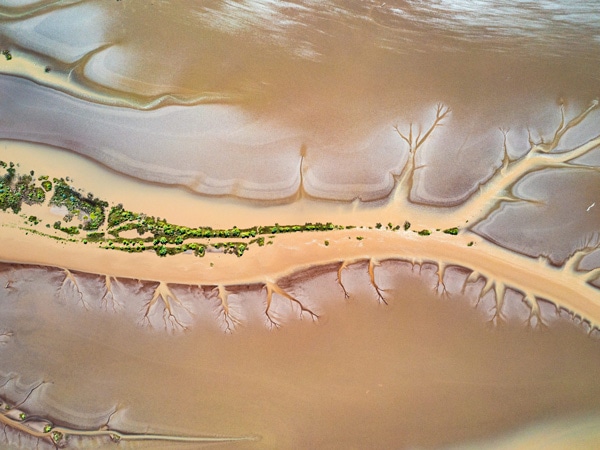
Venture across Kakadu on a helicopter. (Image: Tourism Australia)
Rise above verdant savannah woodlands, whizz past rocky escarpments and soar over exposed rocks that make up some of the world’s oldest. Watch magnificent waterfalls come into view, so close that you can almost feel the spray.
Kakadu Air Services are a local operator have scenic flights ranging from 20 minutes to an hour, and the Scenic Flight Company have flight options ranging from 30 minutes to 1 hr 45 minutes. A Kakadu scenic flight is the best way to witness the landscape and get your adrenaline pumping, too.
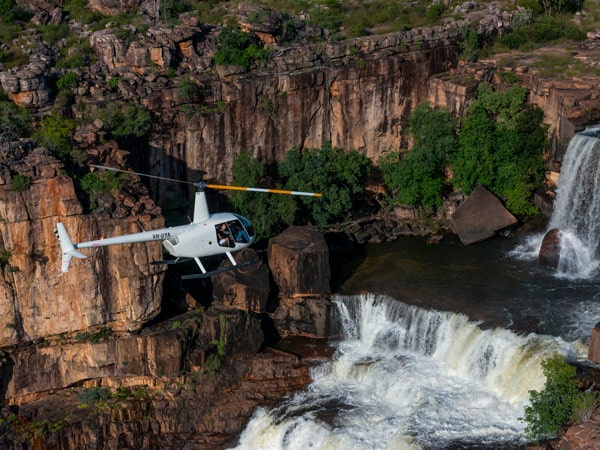
Take a scenic flight above Jim Jim Falls. (Image: Tourism NT)
Flights depart from the townships of Jabiru, Cooinda or Darwin.
If you’re planning a trip to Kakadu National Park, we’ve rounded up everything you need to know before you go .
Elizabeth Whitehead has been a travel writer since she realised the most interesting stories are the ones about the world we live in. When she’s not writing, you’ll find her baking focaccia, birdwatching or exploring in her campervan.

LEAVE YOUR COMMENT
Cancel reply.
Save my name, email, and website in this browser for the next time I comment.
Comments (2)
Awesome info, thank you!!
I was there it is beautiful, even no more beautiful than in the photos
You might also like
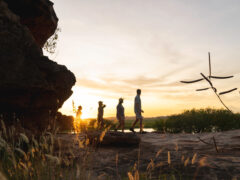
9 immersive Kakadu tours you must experience
Kakadu is not only steeped in natural beauty – it also holds 65,000 years of Indigenous history. Choosing which tours to do in Kakadu National Park...
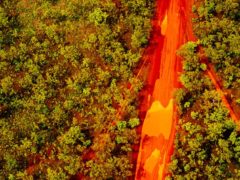
How to road trip Kakadu and itineraries for visiting
There’s no shortage of great tours on offer in Kakadu, but a do-it-yourself driving adventure holiday is pretty hard to beat, says Lee Atkinson The...
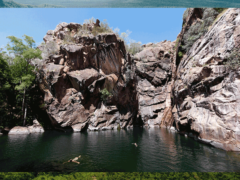
Yes, you should go to Kakadu in Wet Season
Myth has it that Kakadu is best visited during the calm and cloudless dry season. But intense weather seeds surprise, adventure and new life. We go in...
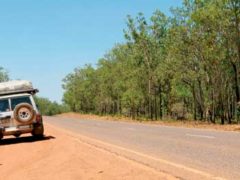
West Alligator Head Camping Adventure
Australian Traveller looks at the remote camping outpost of West Alligator Head in NT's Kakadu National Park. When it comes to camping, we’ve tried...
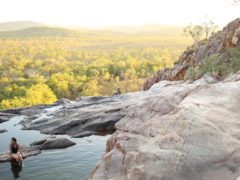
The best routes for walking and hiking in Kakadu
Kakadu National Park is a mini-world that’s better explored on foot than on wheels, and better swum inside than feared from the water’s edge. Here...
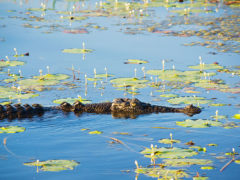
Kakadu FAQs: How, where & the wet season conundrum
Wet season or dry season? Kids or no kids? Walk or drive? Kakadu Tours or self guided? These are just some of the most frequent Kakadu questions we ...

© Australian Traveller Media 2024. All rights reserved.

Australia Recommends 2024

Come and Say G'day

G'day, the short film

Discover your Australia

Travel videos

Deals and offers

Australian Capital Territory

New South Wales

Northern Territory

South Australia

Western Australia

External Territories

The Whitsundays

Mornington Peninsula

Port Douglas

Ningaloo Reef

Airlie Beach

Kangaroo Island

Rottnest Island

Hamilton Island

Lord Howe Island

Tiwi Islands

Phillip Island

Bruny Island

Margaret River

Barossa Valley

The Grampians

Hunter Valley

Yarra Valley

McLaren Vale

Glass House Mountains

Alice Springs

Uluru and Kata Tjuta

The Kimberley

Flinders Ranges

Kakadu National Park

Eyre Peninsula

Karijini National Park

Great Barrier Reef

Blue Mountains

Daintree Rainforest

Great Ocean Road

Purnululu National Park

Cradle Mountain-Lake St Clair National Park

Litchfield National Park

Aboriginal experiences

Arts and culture

Festivals and events

Food and drink

Adventure and sports

Walks and hikes

Road trips and drives

Beaches and islands

Nature and national parks

Eco-friendly travel

Health and wellness

Family travel

Family destinations

Family road trips

Backpacking

Work and holiday

Beginner's guide

Accessible travel

Planning tips

Trip planner

Australian budget guide

Itinerary planner

Find a travel agent

Find accommodation

Find transport

Visitor information centres
Deals and travel packages

Visa and entry requirements FAQ

Customs and biosecurity

Working Holiday Maker visas

Facts about Australia

Experiences that will make you feel like an Aussie

People and culture

Health and safety FAQ

Cities, states & territories

Iconic places and attractions

When is the best time to visit Australia?

Seasonal travel

Events and festivals

School holidays

Public holidays
How to get to Australia's most iconic cities

How long do I need for my trip to Australia?

How to travel around Australia

Guide to driving in Australia

How to hire a car or campervan

How to plan a family road trip

How to plan an outback road trip

Gunlom Falls, Kakadu National Park, Northern Territory
Guide to Kakadu National Park
- Share Share on Facebook Share on Messenger Share on Twitter Share on WhatsApp Copy Link
- Getting to Kakadu National Park
- When to visit
Experience the magic of World Heritage-listed Kakadu National Park on an outback adventure that defies expectation.
In Australia's biggest national park you'll find rugged escarpments, lush rainforest and rock art galleries up to 20,000 years old. Learn about Aboriginal culture from Traditional Owners, the Bininj/Mungguy people, take in thundering waterfalls and witness millions of migratory birds among the wetlands. Experience Kakadu's magic in six dramatically different seasons.
International flights arrive directly into Darwin International Airport (DRW) from many global hubs. Follow the Nature's Way route from Darwin for a scenic adventure through the Top End.
- Darwin International Airport (DRW) is located a three-hour drive outside of Kakadu National Park
- Car hire options are readily available from Darwin Airport or in Darwin city, though it’s best to book ahead
- Or leave the driving up to someone else and join a coach or small group tours from Darwin to Kakadu National Park
While it is not required, it is recommended to hire a 4WD if you are self-driving in the national park. Be sure to refuel your vehicle as frequently as possible on your way. Unleaded and leaded petrol and diesel fuel are available at Jabiru and Cooinda .
Because of the remote location of Kakadu National Park, there is no public transport available to get to, or around the park.
The dry season (May - September) or the transitional periods between the dry and wet season (April/May and September/October) are considered the best time to travel to Kakadu National Park.
- High season: Dry season (May-September)
- Low season: Wet season (October - April)
- Don’t miss: the annual ‘Taste of Kakadu’ festival (May)
Trips and itineraries

Ultimate 6-day Kakadu family road trip

Waterhole hopping in the Northern Territory

10 days of Australian Aboriginal experiences

14-day road trip from Darwin to Adelaide
Destinations near kakadu national park.

Arnhem Land
Travellers' stories.

Planning your trip to Australia?
Get expert help from an aussie specialist who has the knowledge and experience to help you plan and book every detail of your trip., featured articles.

We use cookies on this site to enhance your user experience. Find out more . By clicking any link on this page you are giving your consent for us to set cookies.
Acknowledgement of Country

We acknowledge the Traditional Aboriginal and Torres Strait Islander Owners of the land, sea and waters of the Australian continent, and recognise their custodianship of culture and Country for over 60,000 years.
- International (English)
- New Zealand (English)
- Canada (English)
- United Kingdom (English)
- India (English)
- Malaysia (English)
- Singapore (English)
- Indonesia (Bahasa Indonesia)
- Deutschland (Deutsch)
- France (Français)
- Italia (Italiano)
- 中国大陆 (简体中文)
*Product Disclaimer: Tourism Australia is not the owner, operator, advertiser or promoter of the listed products and services. Information on listed products and services, including Covid-safe accreditations, are provided by the third-party operator on their website or as published on Australian Tourism Data Warehouse where applicable. Rates are indicative based on the minimum and maximum available prices of products and services. Please visit the operator’s website for further information. All prices quoted are in Australian dollars (AUD). Tourism Australia makes no representations whatsoever about any other websites which you may access through its websites such as australia.com. Some websites which are linked to the Tourism Australia website are independent from Tourism Australia and are not under the control of Tourism Australia. Tourism Australia does not endorse or accept any responsibility for the use of websites which are owned or operated by third parties and makes no representation or warranty in relation to the standard, class or fitness for purpose of any services, nor does it endorse or in any respect warrant any products or services by virtue of any information, material or content linked from or to this site.

23 Must-Dos in Kakadu National Park + Itinerary Ideas (2024)
Looking for things to do in Kakadu National Park? This guide highlights the very best, along with some suggested Kakadu itinerary ideas.
Kakadu National Park is a vast and diverse landscape located in the Top End of Australia. It’s usually top of visitors’ Australia bucket list experiences , with cultural sites, wildlife, flora, fauna and scenery unlike anywhere else in Australia – or even on Earth.
Not far from the Northern Territory capital city of Darwin, Kakadu is an Australian icon. While it’s no longer Australia’s largest national park (that crown was taken by Munga-Thirri/Simpson Desert National Park in 2021), it’s a HUGE park – almost a third of the size of Tasmania!
Having just spent almost a week in this UNESCO World Heritage-listed site, I’ve pulled together a guide to what I think are the must-dos for anyone visiting Kakadu, as well as some handy travel tips.
There’s no shortage of things to see and do in Kakadu National Park and it can be overwhelming to visit, so I’ve also created some suggested itineraries to help you plan your trip.
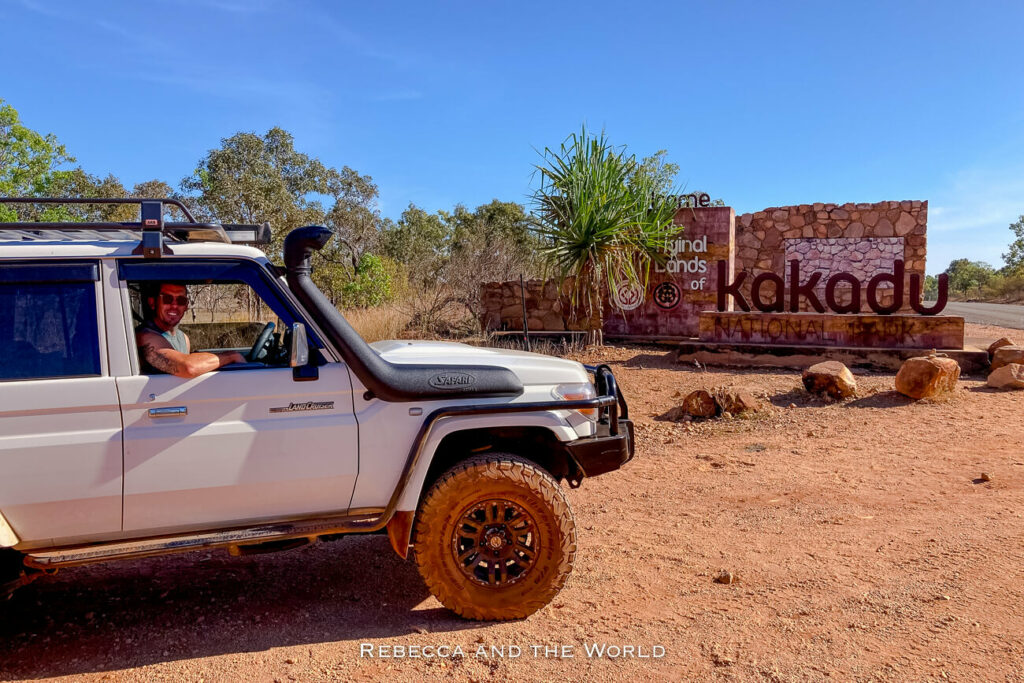
This blog post may contain affiliate links, meaning if you book or buy something through one of these links, I may earn a small commission (at no extra cost to you).
What's in this article (Click to view)
Need to know before you visit Kakadu National Park
Is it free to visit kakadu national park.
You’ll need to buy a Kakadu National Park Pass to enter. You can buy this online in advance or at the visitor centre when you arrive at the park.
A 7-day pass costs $40 for adults and $20 for kids.
While you may already have an NT Parks Pass if you’ve visited Nitmiluk National Park or Litchfield National Park , it won’t work here.
Is there mobile phone reception in Kakadu?
Mobile reception is very patchy in Kakadu. We only had reception in Jabiru and at Cooinda Lodge (sometimes). It still surprises me how bad mobile coverage is in remote parts of this country!
Visitor centre
I recommend stopping in at the visitor centre before you head further into the park.
The Bowali Visitor Centre is located at the northern entrance to the park and is a great place to learn about the traditional owners of Kakadu, their culture and the environment.
Make sure you pick up a Kakadu Visitor Guide – it’s the best printed resource about the national park. You can also download a copy online here .
There was a visitor centre at the south entrance, but it’s now closed (although the toilets are usually open). This is why I recommend (if you can) entering Kakadu from the north rather than the south. But, of course, that’s not always possible.
Plan your Kakadu visit
As I’ve already said – and will say again – Kakadu is huge. You really do need to plan your visit around key sites, otherwise you’ll be driving a lot! This may mean you’ll need to change accommodation throughout your visit so that you can be closer to different sections of the park.
I’ve got some itinerary ideas later on in this article to help you with this.
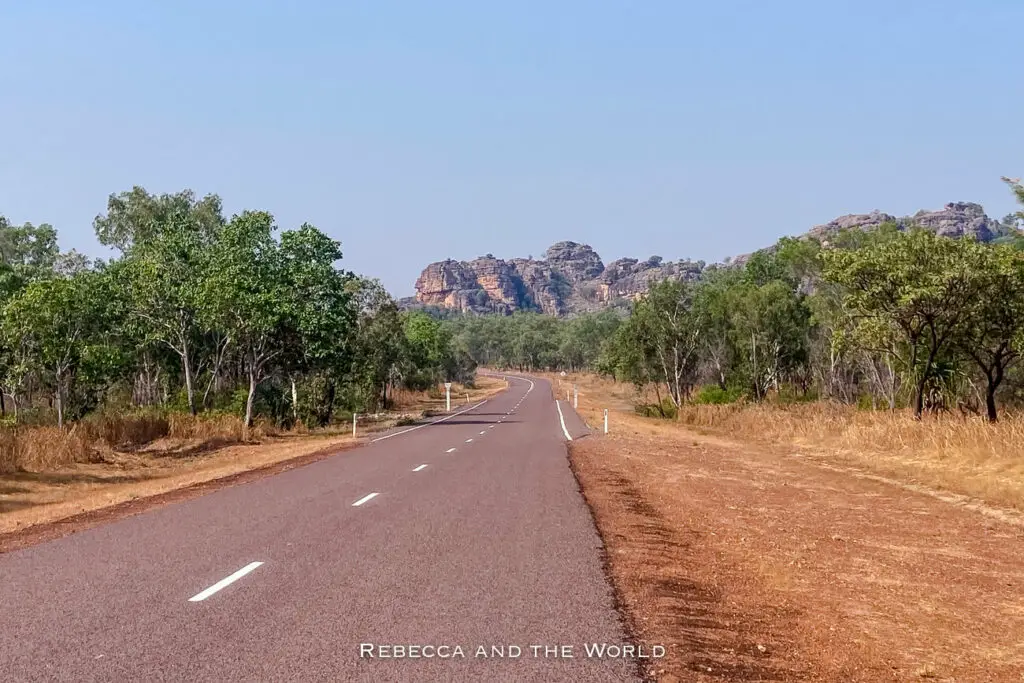
Is Kakadu open?
Parts of Kakadu can close – whether that’s due to damage, flooding or something else. Check the latest status of Kakadu attractions online here .
Map of Kakadu National Park
Everything I mention in this article is laid out on this Kakadu National Park map.
Things to do in Kakadu National Park
As I’ve already said, Kakadu is huge, so I’ve broken this article up into the 7 regions of the national park. This will help you plan your days around activities in each region, so you’re not driving back and forth.
These 7 regions are:
South Alligator region
Jabiru region, east alligator (erre) region, burrungkuy (nourlangie) region.
- Yellow Water region
- Jim Jim / Twin Falls Gorge region
Mary River region
If you’re coming from Darwin to Kakadu, the South Alligator region is where you’ll enter the national park.
1. Mamukala Wetlands
Mamukala Wetlands is a twitcher’s heaven. Head to the observation platform to see hundreds of birds, including magpie geese, ducks and herons, feeding in the wetlands.
If you have extra time, take a walk along the boardwalk to learn about Aboriginal use of plants and animals in this area. The 3-kilometre trail takes a leisurely 1-2 hours to complete.
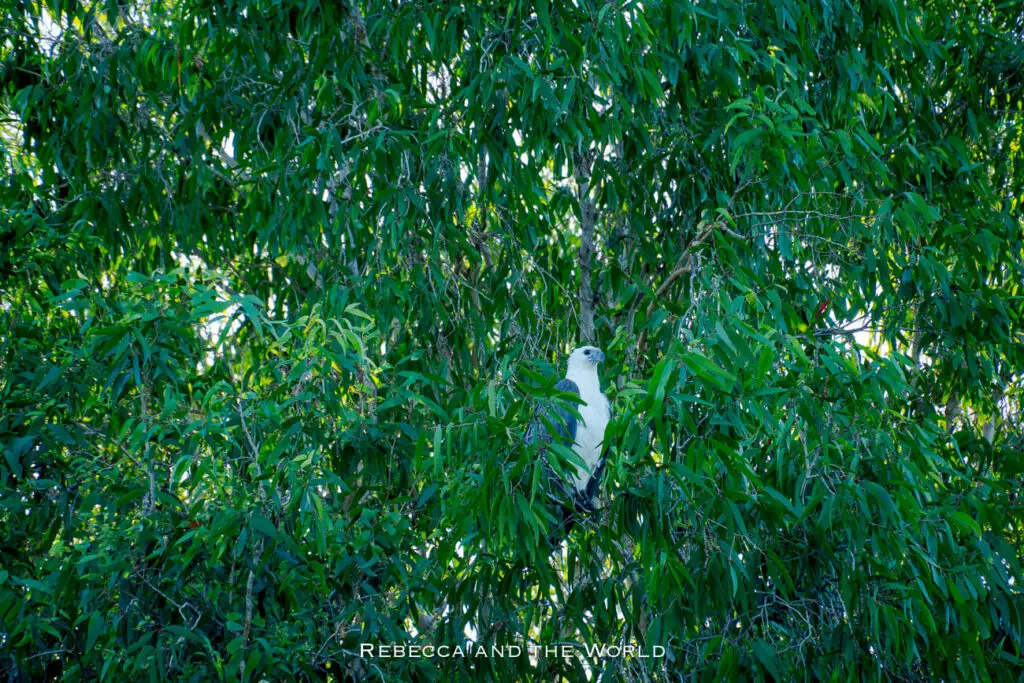
2. Boating/fishing
The South Alligator area is also a popular spot for fishing and boating for intrepid travellers. There are a few boat ramps to access the South Alligator River, some of them remote and only accessible by 4WD.
Fun fact: Why alligator and not crocodile? When the Kakadu area was first visited by Europeans, they mistakenly thought the reptiles were alligators. The rivers were named East Alligator River and South Alligator River. But as we of course know, they’re actually saltwater crocodiles. Despite that, the original alligator name has stuck.
The main town of Kakadu is called Jabiru and it has a supermarket, petrol station, mechanic, pharmacy and post office.
There are also a few hotels here, so it’s a good spot to base yourself at the beginning of your visit to Kakadu.
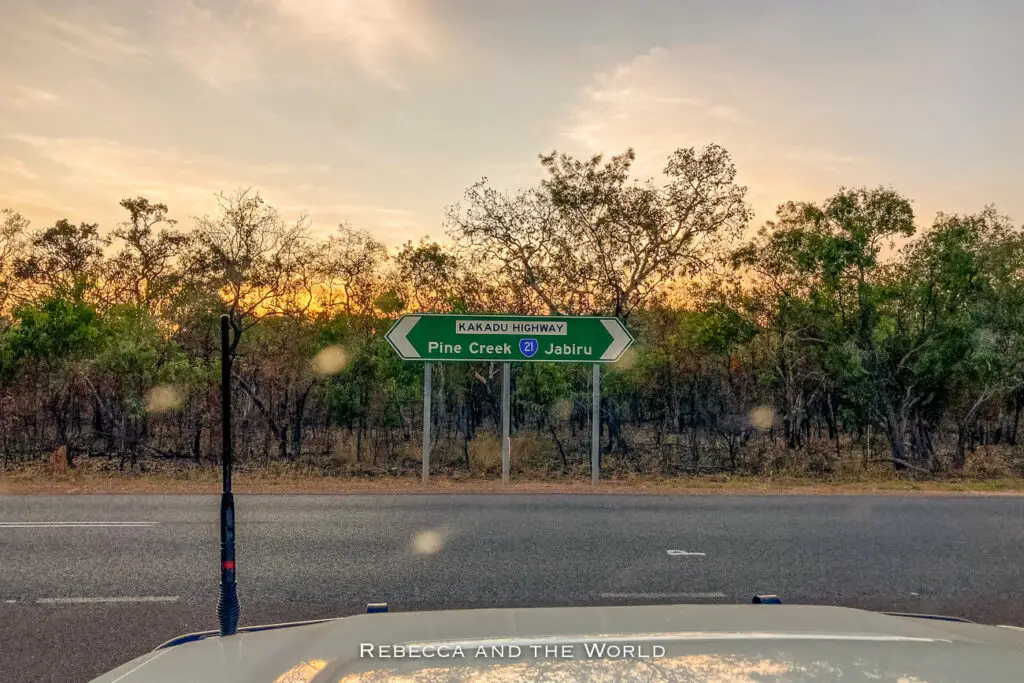
3. Bowali Visitor Centre
As I mentioned earlier, the Bowali Visitor Centre should be your first stop in Kakadu. Pick up a Kakadu Visitor Guide and chat with the rangers about what’s open and closed. They have great tips about the best time to visit certain spots for views and lighting.
If you haven’t bought your Kakadu park pass online, you can buy one here.
There are some interesting exhibitions about the flora and fauna of Kakadu and the Traditional Owners of the area, so spend some time here learning more about the national park
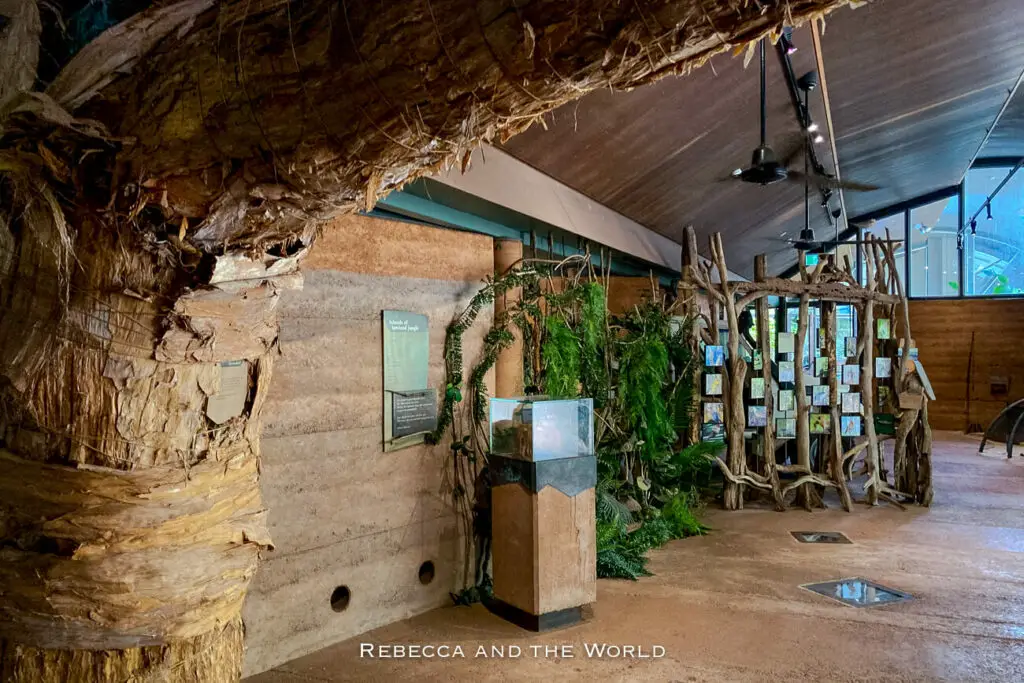
4. Bowali Track
Start your time in Kakadu by tackling a smaller hiking trail. The Bowali Track is a 4-kilometre return that takes you through woodlands. Keep an eye out for birds, wallabies, and maybe even a buffalo.
The trail begins opposite the Mercure Kakadu Crocodile Hotel – a hotel that’s shaped like a croc!
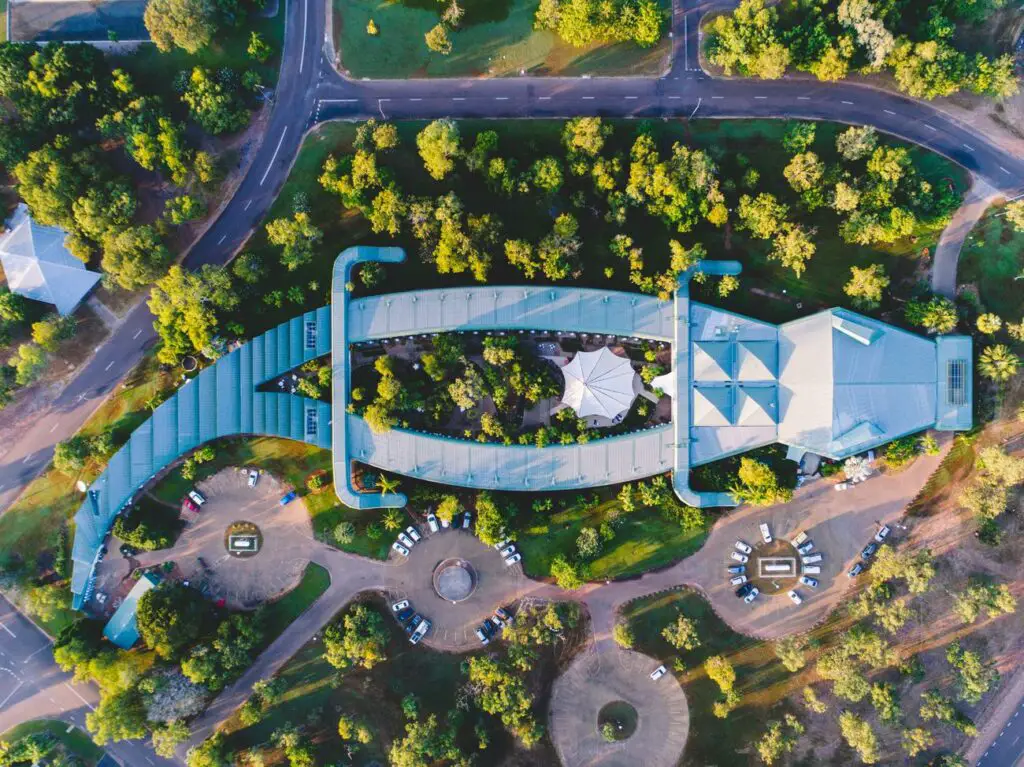
5. Marrawuddi Arts & Culture
Owned by the Mirarr Traditional Owners, the Marrawuddi Arts & Culture centre is a great place to see and buy authentic Indigenous art and crafts from across Kakadu and West Arnhem Land.
You can find everything here from bark paintings to weavings and sculptures, screen-printed T-shirts, jewellery and artworks on canvas.
There’s a studio space here, too, so you can often see artists at work creating intricate and beautiful artworks and designs.
The cafe here has good coffee – and it’s open 7 days.
The East Alligator River is the boundary between Kakadu and Arnhem Land.
One of the absolute highlights of visiting Kakadu is watching the sun set from Ubirr.
At the top of this rock formation, from the Nadab Lookout, you’ll find incredible views stretching out over the vast Kakadu floodplains all the way to Arnhem Land.
Follow the track to the rocky lookout, stopping to see Aboriginal rock art sites. There are several galleries with artworks from different time periods. The oldest paintings here date back thousands of years.
We took a free guided tour led by one of the Indigenous rangers. It was interesting, although our guide seemed far more focused on cracking jokes than sharing useful information. It was worth it, though, as we did learn a few things along the way.
The trail is flat but you’ll need to climb up the rocks to get to the lookout.
This is one of the most popular things to do in Kakadu and it gets really busy here at sunset, so come early to get a good spot. Bring a picnic (no alcohol allowed).
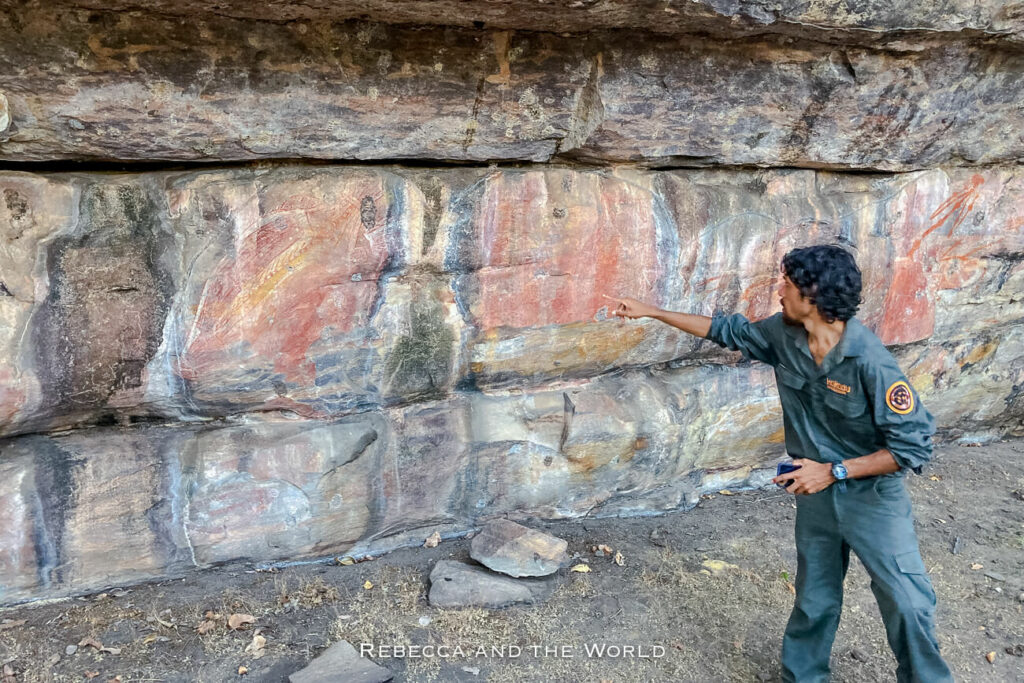
7. Cahills Crossing
If you want to see some crocodiles, Cahills Crossing is the place to be. Located at the East Alligator River, this crossing is a popular spot for fishing and also for watching saltwater crocodiles in their natural habitat. There’s a spacious viewing platform that’s mostly shaded.
This is a tidal river, so time your visit here for high tide when the crocodiles come looking for fish.
I couldn’t believe how many crocs we saw floating down the river or surfacing right by the crossing – and we weren’t even there at high tide.
We saw a few cunning crocs making a beeline when someone fishing reeled in a catch.
If you’re here in the evening during the dry season, there’s an informative talk – led by a ranger – about Kakadu and its resident crocodiles.
Lots of people cross here by car for fun and then turn back. You need a permit if you’re planning on driving further into Arnhem Land.
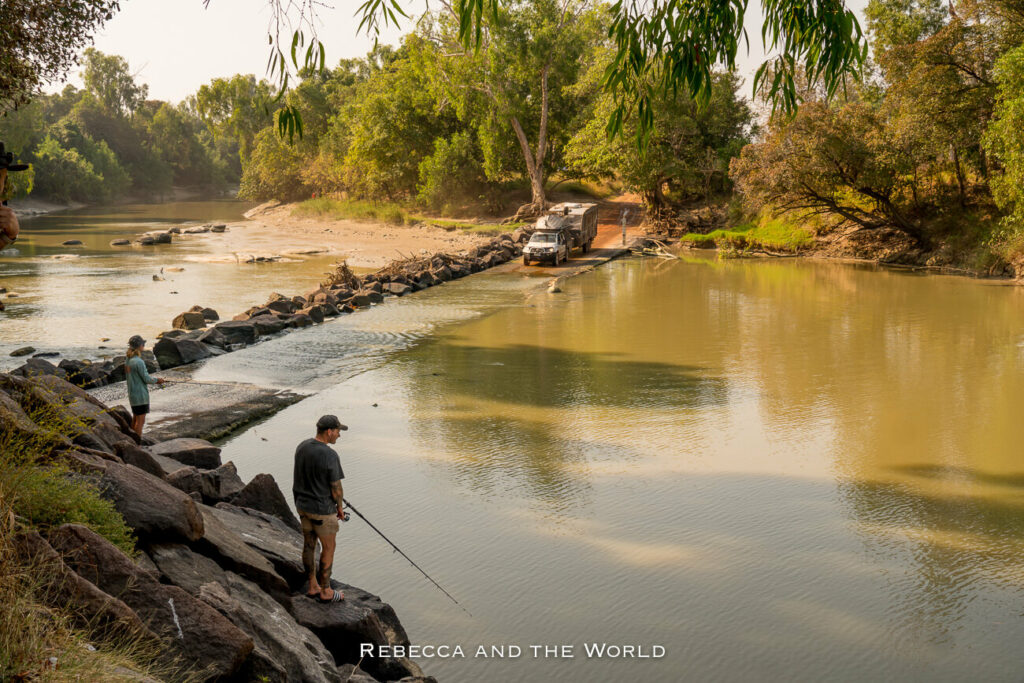
8. Guluyambi Cultural Cruise
Kakadu has a lot to offer when it comes to adventure and exploration, but it’s also a special place for the Traditional Owners of this land. The Guluyambi Cultural Cruise is a must-do experience to gain insight into the Indigenous way of life in Kakadu.
The one-hour cruise takes you along East Alligator River, which separates Kakadu and Arnhem Land, with a knowledgeable guide providing commentary on the history and traditions of the local people.
You’ll even get to go on the Arnhem Land side of the East Alligator River for a hunting and gathering display.
It’s one of the most interesting things to do in Kakadu National Park if you’re interested in learning about culture.
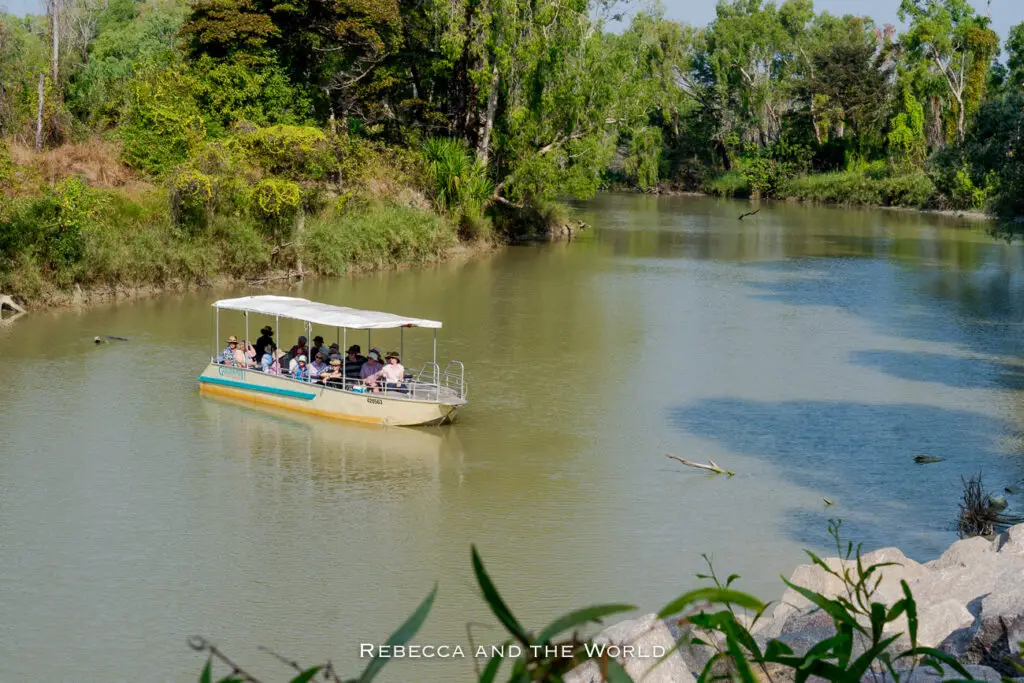
9. Manngarre Rainforest Walk
After you’ve gazed at rock art or spotted crocs, take one of the three loop trails that make up the Manngarre Rainforest Walk.
The trails range from 0.6 kilometres to 1.5 kilometres, and meander through the monsoon rainforest.
10. Injalak Arts Centre
This remote art hub is in West Arnhem Land, just a 25-minute drive from Ubirr. This centre has been around since 1989.
More than 200 artists make and sell beautiful weavings, bark paintings, jewellery, carvings and textiles. Everything here is unique – and ethically sourced and sold.
You will need to arrange permits to visit Gunbalanya (the community where Injalak Arts is located). Information about how to do this is online here .
This region is home to incredible art sites and more stunning lookouts.
11. Burrungkuy (Nourlangie)
This area has a long history of occupation – more than 20,000 years.
Follow the 1.5km return trail – a mix of earth trails and boardwalks – to see rock art painted over thousands of years in shelters used by Aboriginal people.
At Burrungkuy (Nourlangie), you’ll see paintings of people, kangaroos and fish, as well as the famous Lightning Man. Namarrkon (Lightning Man) is depicted as a grasshopper-like creature who makes the powerful lightning and thunderstorms every summer.
You’ll also see Nabulwinjbulwinj, a dangerous spirit who eats women after killing them. You’re asked not to photograph this rock art site.
If you continue on the trail, you’ll reach Gunwarrdehwardeh (also spelt Kunwarddewardde) Lookout. From here you can see for miles over Kakadu National Park, including over to where Namarrkon lives. It’s said that if his home is disturbed, trouble will come.
It’s a really peaceful place and the only noises you’ll hear (other than people) are the sounds of birds and the wind gently swishing the trees.
If you have the energy (and food and water supplies), you can continue from here onto the Barrk Walk, a 12km loop that’s a difficult hike. It loops up with the Nanguluwurr rock art site. We would have loved to do this – but weren’t prepared with enough water.
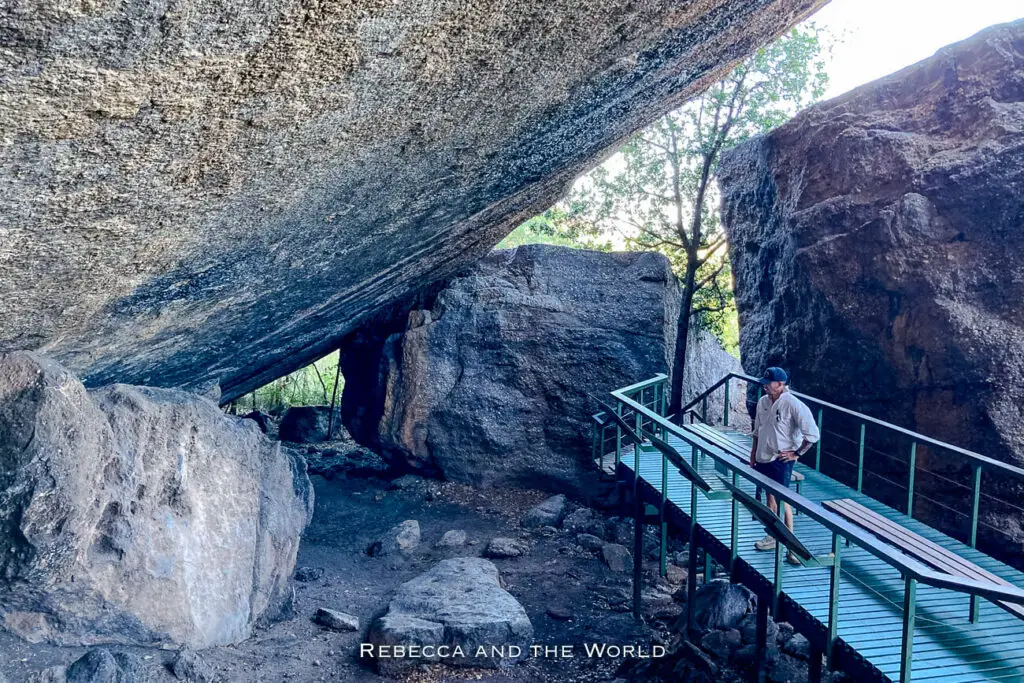
12. Nawurlandja Lookout
Nawurlandja Lookout is at the end of a short walk (600m return). It’s a steep-ish track over the rock face – I was puffing by the time I reached the top!
This lookout has spectacular views over Anbangbang Billabong, Burrungkuy (Nourlangie) and Arnhem Land.
It’s particularly stunning at sunset, with the sky turning orange and pink and purple. We found it was much quieter here than Ubirr at sunset.
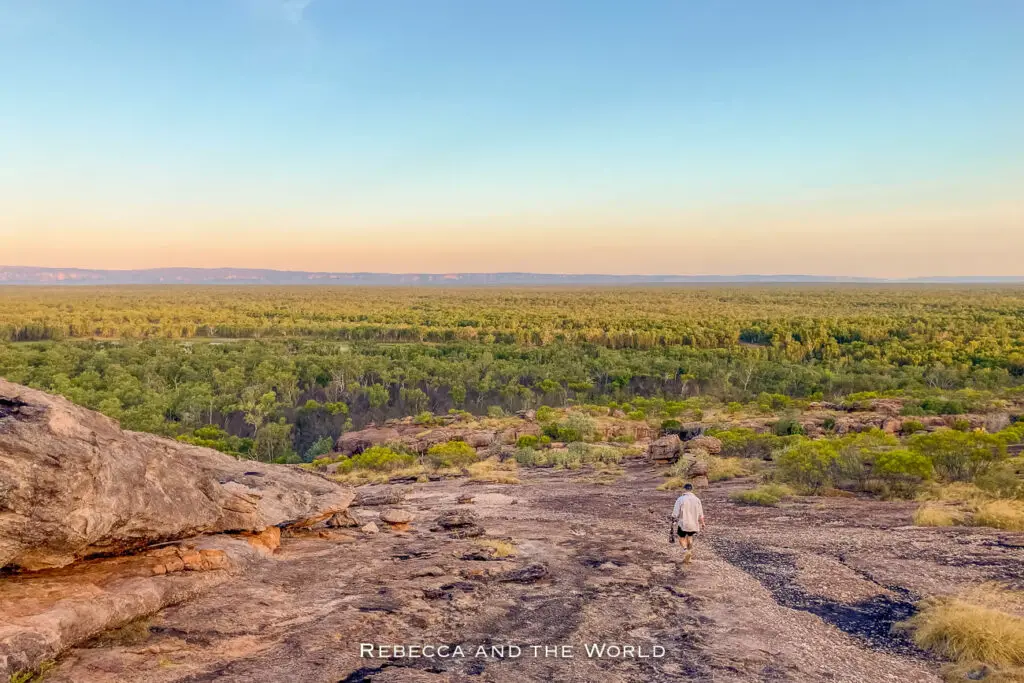
13. Nanguluwurr
This was one of our favourite rock art sites in Kakadu – not only for the fascinating art but also because we had it all to ourselves. I’m not sure if that’s common, but it was pretty incredible to be able to take in the history here without being disturbed by any other visitors.
It’s an easy, 4km return walk to the Nanguluwurr art gallery. It’s here you’ll see the painting of a masted sailing ship – a representation of early contact between Aboriginal people and Europeans.
There are also handprints and the typical animals in x-ray style, all painted in ochre.
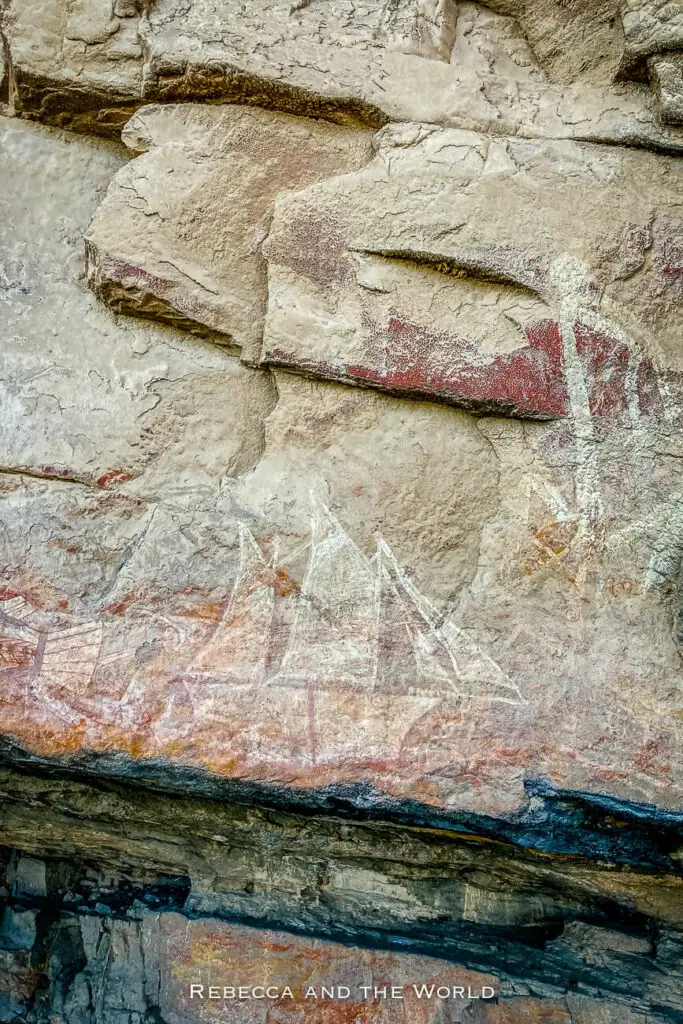
14. Anbangbang Billabong
Not far from Burrungkuy (Nourlangie) is Anbangbang Billabong, a peaceful and picturesque wetland. It’s a great spot to see birdlife (and probably some crocodiles, too – although we didn’t see any here).
Take the 2.8km easy loop around the billabong, passing through paperbark forest and savanna woodlands.
It’s also incredibly peaceful and usually not crowded at all. There are some picnic tables here.
I recommend coming here in the afternoon, either before or after visiting the rock art sites at Burrungkuy (Nourlangie), and then heading up to Nawurlandja Lookout for sunset.
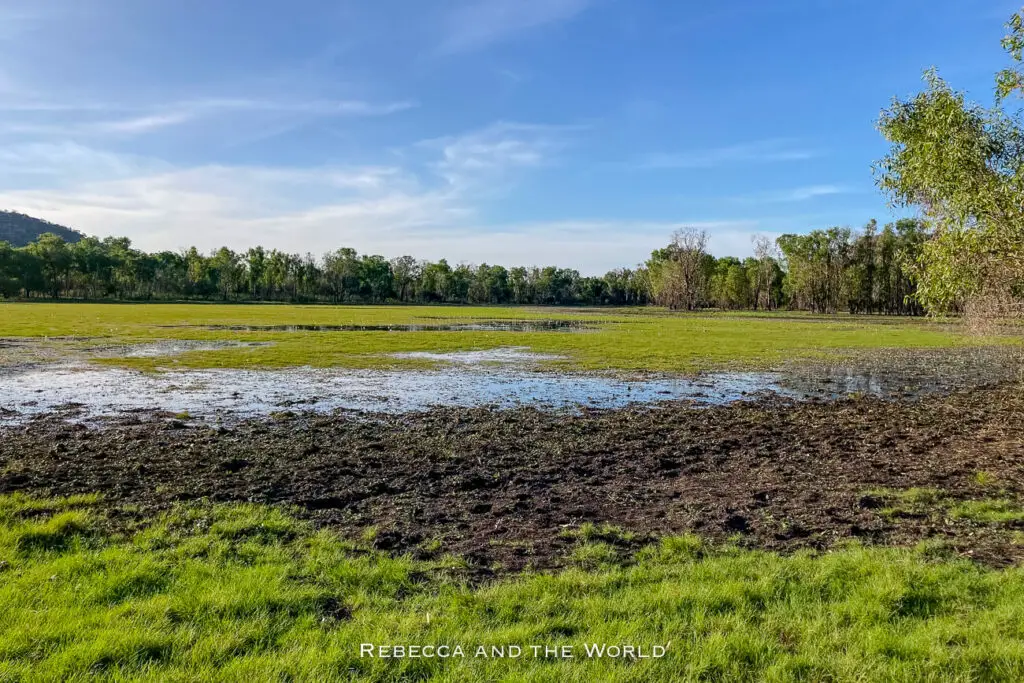
Yellow Water (Ngurrungurrudjba) region
Apart from the Jabiru region, this is the busiest part of Kakadu. Cooinda Lodge has a range of accommodation, so this can be a good base to explore the southern part of the park.
15. Yellow Water Cruise
After exploring the land and learning about its history, it’s time to take a cruise on Yellow Water Billabong (Ngurrungurrudjba) and the South Alligator River.
This 1.5 hour boat ride is one of the must-do experiences in Kakadu National Park. It’s such an informative tour and the scenery is remarkable.
You’ll cruise through beautiful wetlands teeming with wildlife – from birds to saltwater crocodiles. We even spotted several water buffalo roaming the floodplains.
Our guide, Jess, was excellent. She shared so much about the flora and fauna of the region, as well as the cultural significance of Yellow Water Billabong to the Traditional Owners, the Bininj/Mungguy people. We learned some of the traditional names of the animals as well.
Crocs are of course the highlight of this boat trip. I started counting them at the start but gave up after a while – they are everywhere . There are estimated to be more than 10,000 crocodiles in Kakadu.
But there was also a huge focus on fascinating birds. We saw magpie geese, rainbow bee eaters, a few white-bellied sea eagles (the second-largest bird of prey) and the nankeen night heron, which we learned loves to stare at itself in the water.
I recommend taking a sunrise or sunset cruise for the best light and to get out of the heat of the day (although the boats are covered). It was incredible to see the huge orange sun sinking over the water.
Book well in advance – these tours sell out very quickly.
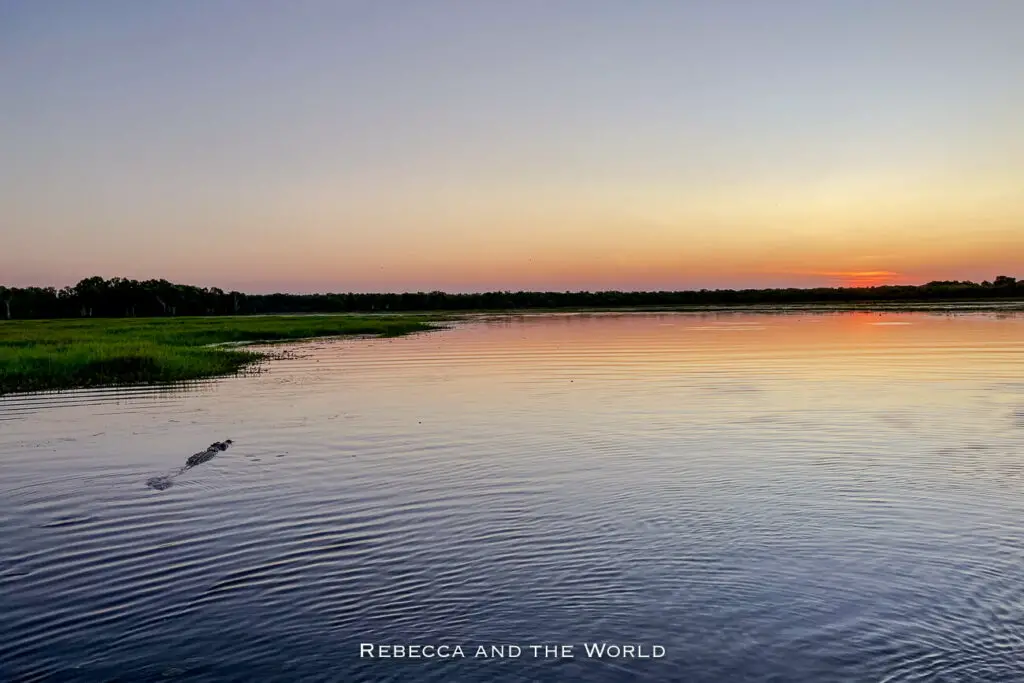
16. Warradjan Aboriginal Cultural Centre
The Warradjan Cultural Centre focuses on the Aboriginal heritage of Kakadu through interactive displays and exhibits.
Warradjan means pig-nosed turtle, and this impressive building is built in the shape of this marine reptile.
There are informative exhibits on the moiety system, the six different seasons of Kakadu, the wildlife of Kakadu and Creation stories.
But there are also displays about the arrival of the balanda (Europeans) and the history of mining in Kakadu, both of which have had devastating impacts.
Top tip! The building is also air-conditioned, so it’s a nice place to escape the heat of the day and learn about the rich culture and history of Kakadu.
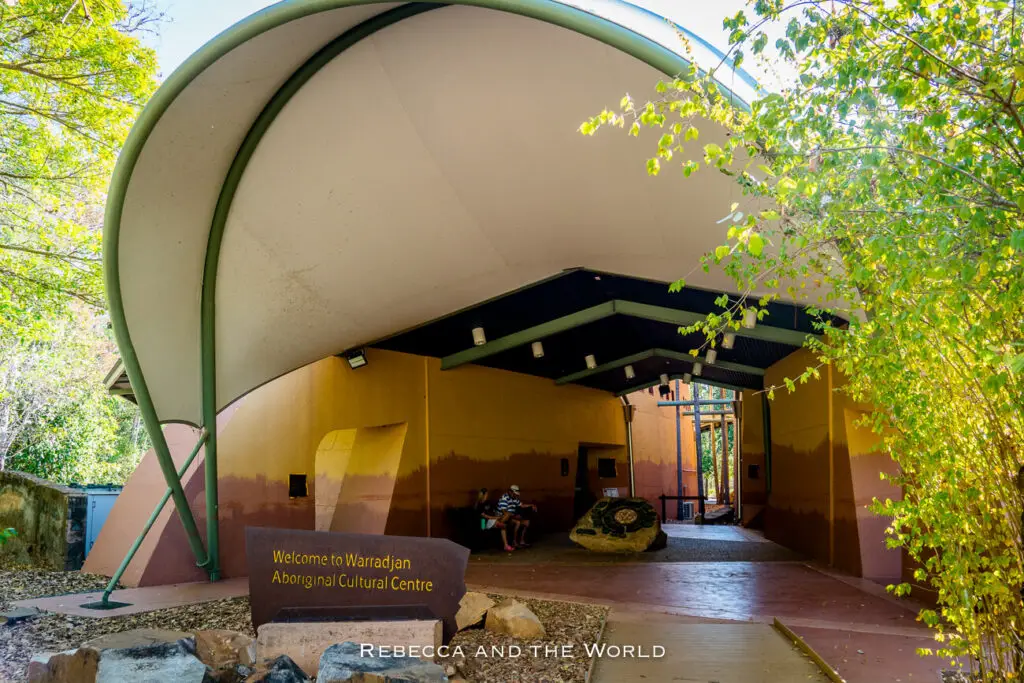
17. Cooinda Lodge
If you’ve been camping in Kakadu (as we were), then Cooinda Lodge will be a welcome stop.
There’s a restaurant here as well as food tents at night, a fuel station, a store selling snacks and drinks – and it’s also the place where you can book tours.
There’s also (very) limited phone reception to catch up – we could only ever get patchy 3G coverage.
18. Take a scenic flight over Kakadu National Park
For a bird’s eye view and a truly breathtaking experience, consider taking a scenic flight over Kakadu National Park.
You’ll be able to see the vastness of the landscape, the winding rivers, and even spot wildlife from above.
This is the best way to see Kakadu in the Wet – when you may not be able to get on the ground but will be able to see waterfalls at their mightiest from above.
There are several companies that offer scenic flights over Kakadu , so shop around and compare prices and itineraries.
Flights depart from Cooinda and Jabiru.
Jim Jim / Twin Falls region
The highlight of Kakadu are these two waterfalls – Jim Jim and Twin Falls Gorge.

19. Jim Jim Falls
Jim Jim Falls is a stunning waterfall located in the southern region of Kakadu National Park.
The falls can only be accessed by 4WD vehicles and require a short hike to reach. But the effort is well worth it once you see the crystal clear water cascading over the red cliffs.
During the dry season, the waterfall dries up from about July, but you can still hike to the plunge pool at the bottom of the cliffs. Salties have been known to appear here, so keep an eye out – and check with the rangers before you take a dip!
The dirt road to Jim Jim Falls can be pretty hairy. Friends we met on our trip had their back window smashed by rocks, so make sure to cover it with cardboard or a yoga mat, just in case!
Don’t have a 4WD? Take a 4WD day tour .
During the wet season, the falls can become impassable and dangerous due to heavy rainfall and flooding. So your best bet at this time of year is to see the falls via a scenic flight.
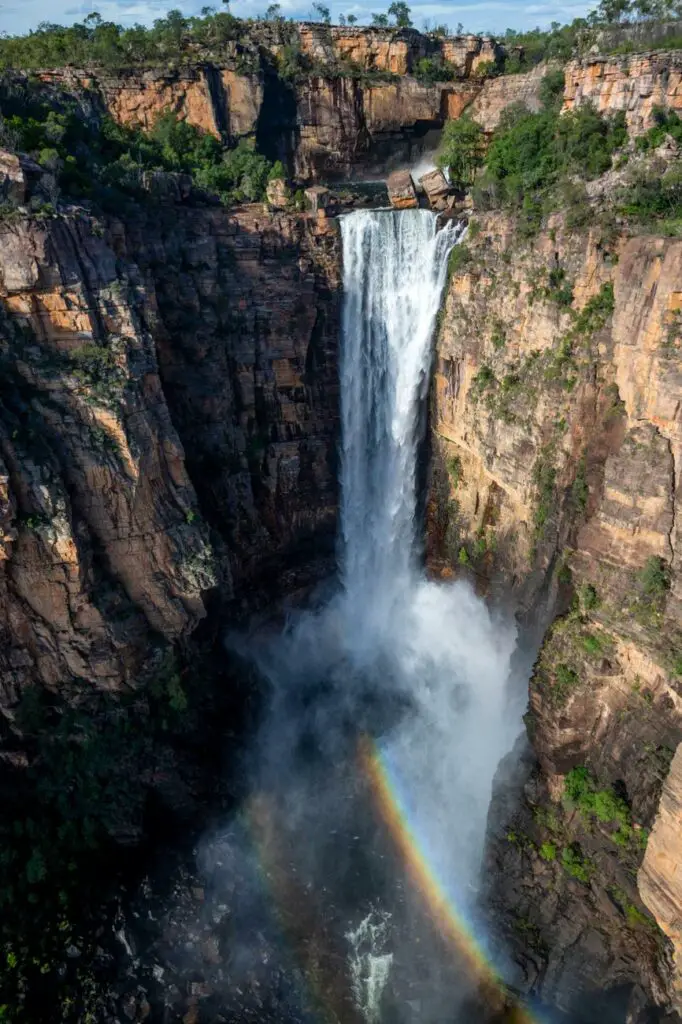
20. Twin Falls
Twin Falls is another must-see attraction in the Jim Jim / Twin Falls region of Kakadu National Park.
This spectacular 150-metre-high waterfall is surrounded by towering cliffs. The waterfall is just a trickle during the dry season, but it’s still worth a walk – the scenery is incredible.
While the walk to the base of the falls is currently closed for an upgrade, you can hike along the top along the Twin Falls plateau walk. This 6km return trail has amazing views down into the gorge and the falls.
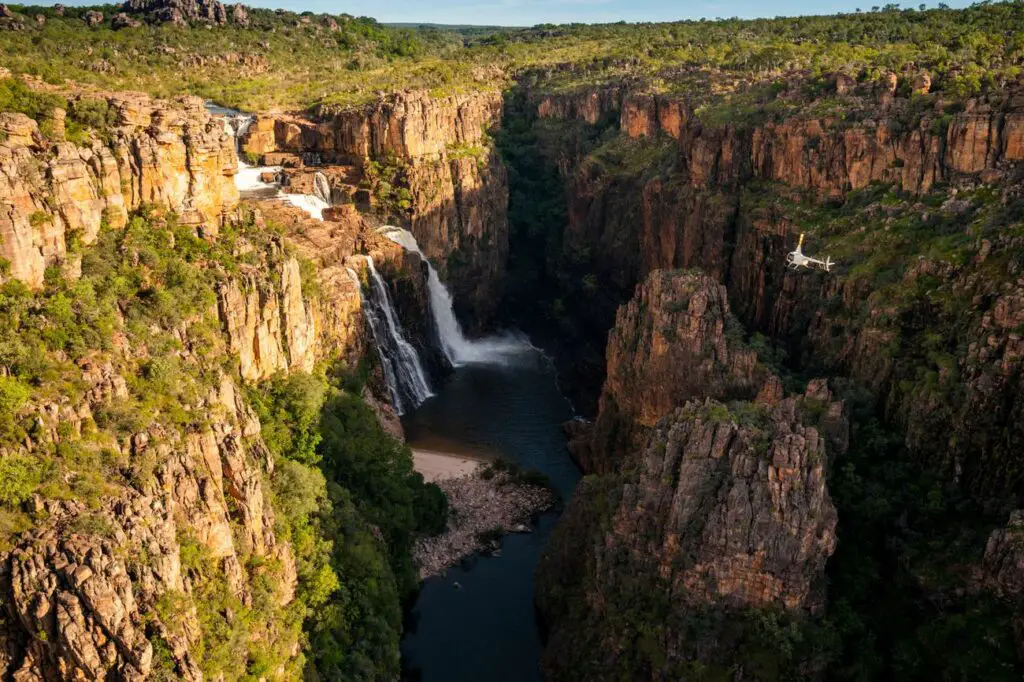
The southernmost region of the national park is easily accessible from the Stuart Highway and is where you’ll find some of Kakadu’s best swimming holes.
21. Maguk Falls
Maguk Falls is a stunning swimming spot – my favourite place in Kakadu National Park.
While the waterfall isn’t as high as Jim Jim or Twin Falls, this place is still spectacular. The water cascades over the rocks and into a deep plunge pool, a much-needed escape from the heat.
To reach Maguk Falls, you’ll need to take a short 1-kilometre hike through lush rainforest, which then gives way to rocks and boulders – watch your step in this part!
Once at the falls, you can swim in the crystal clear waters or relax on the rocky bank. It’s so easy to while away a few hours here. Bring a pool noodle or something inflatable to laze about on.
The road to Maguk is an unsealed, 4WD track, but we saw 2WD cars tackling it easily in the dry season.
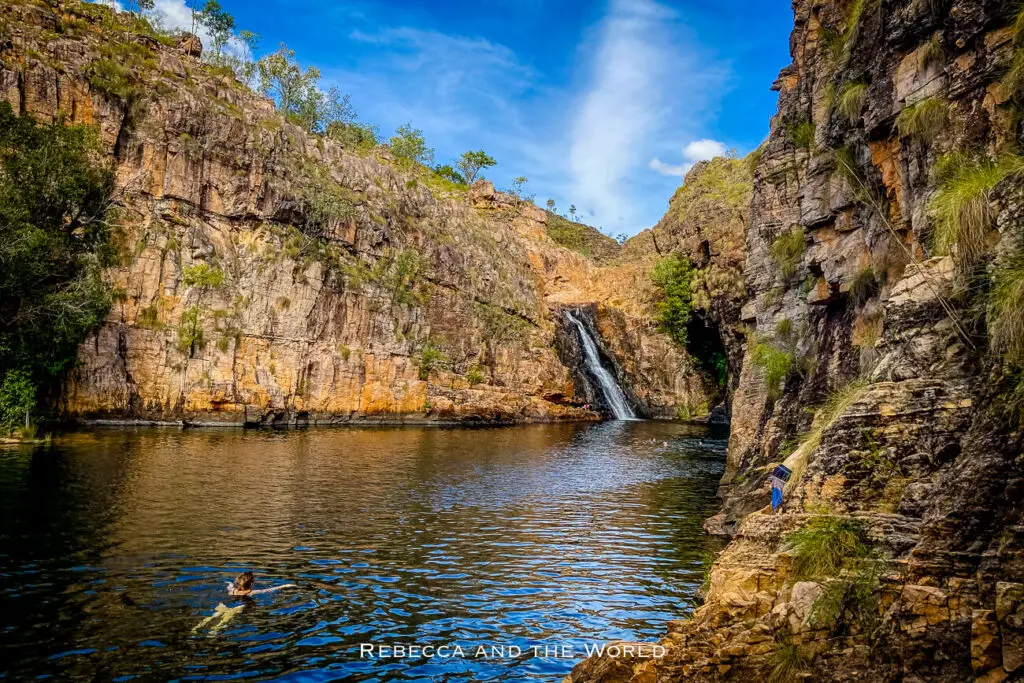
22. Motor Car Falls
Head to Motor Car Falls, one of the lesser visited spots in Kakadu.
The 7.5km return hike is one of the three Yurmikmik Walks.
Motor Car Falls is best during the wet season – although it can close due to flooding in the peak of the season, so you need to time your visit right.
However, it’s still worth visiting during the dry season. While the waterfall won’t be impressive (and may not be flowing at all), the walk is a chance to spot birds and wildlife.
23. Gunlom Falls
Gunlom Falls is where you’ll get the ultimate Instagram shot.
The walk to the falls takes you through lush monsoon forests, before opening up to a beautiful viewpoint over the valley below.
The falls themselves are a series of natural rock pools, perfect for swimming and cooling off on a hot day.
But the real highlight at Gunlom Falls is the infinity pool at the top of the falls. This natural infinity pool overlooks the South Alligator River and offers unbeatable views for a truly unique swimming experience.
Unfortunately, Gunlom Falls was closed when we visited – and has been for some time. So, check the Kakadu status page for updates.
View this post on Instagram A post shared by 👣Hike Australia👣 (@hike_australia)
Kakadu itinerary ideas
So, you’ve now seen that there’s a LOT to do in Kakadu. To help you make the most of your time here, I’ve pulled together a couple of suggested itineraries. These are Kakadu self-drive itinerary ideas, as I’ve assumed you’re visiting independently and not on a tour.
3 days in Kakadu National Park
Three days will give you a good taster of Kakadu National Park.
- Drive from Darwin to Jabiru.
- Stop by Bowali Visitor Centre to pick up a Kakadu Visitor Guide and chat with the rangers.
- Head to Cahills Crossing for a chance to spot crocodiles and other wildlife.
- Catch the sunset at Ubirr Rock, where you can see ancient rock art and enjoy panoramic views of the park.
Stay: Mercure Kakadu Crocodile Hotel , hotel/camping at Aurora Kakadu Lodge or Malabanjbanjdju or Burdulba campgrounds (Merl campground is the closest to Ubirr – but it’s known for having a LOT of mosquitos).
- Visit Burrungkuy (Nourlangie) to see ancient rock art and learn about the local Indigenous history.
- See more rock art at the Nanguluwurr art gallery.
- Head up the Nawurlandja Lookout for stunning views or take a stroll around Anbangbang Billabong.
- Take a sunset cruise on Yellow Water Billabong to see the diverse birdlife and spot saltwater crocodiles.
Stay: Cooinda Lodge or camp at Mardukal campground .
- Visit the Warradjan Cultural Centre to learn about Indigenous culture and history.
- End your trip to Kakadu at one of the following swimming holes for a refreshing swim: Maguk, Gunlom (if it’s open) or Motor Car Falls.
- Head back to Darwin.
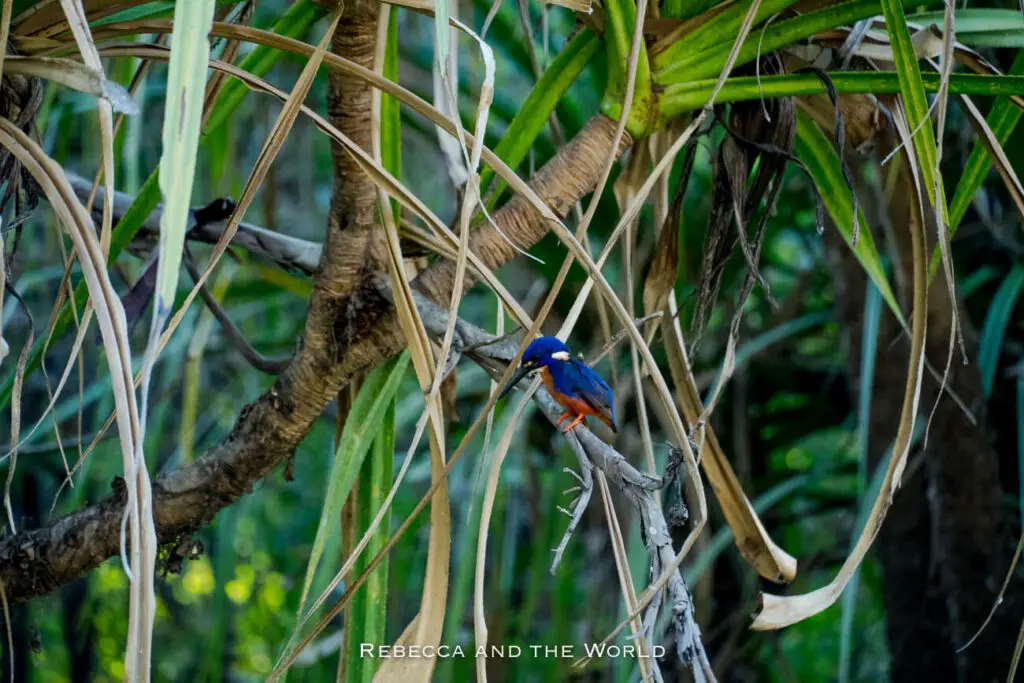
5 days in Kakadu
Five days is a great amount of time to explore more of Kakadu National Park.
- Head to Cahills Crossing to spot crocodiles.
- Catch the sunset at Ubirr Rock, where you can see ancient rock art and enjoy panoramic views over the floodplains all the way to Arnhem Land.
Stay: Mercure Kakadu Crocodile Hotel or camping at Aurora Kakadu Lodge or Malabanjbanjdju or Burdulba campgrounds (Merl campground is the closest to Ubirr – but it’s known for having a LOT of mosquitos).
- Take a Guluyambi Cultural Cruise on the East Alligator River to see more wildlife and learn about the local Aboriginal culture.
- Head out to Injalak Arts to see incredible Aboriginal art (arrange your permit ahead of time).
- Head up to Nawurlandja Lookout for stunning sunset views.
- Visit the Warradjan Cultural Centre to learn about the local Indigenous culture and history.
- Explore the Jim Jim and Twin Falls area, taking in the impressive waterfalls and stunning landscapes.
Stay: Cooinda Lodge or Karnamarr Campground .
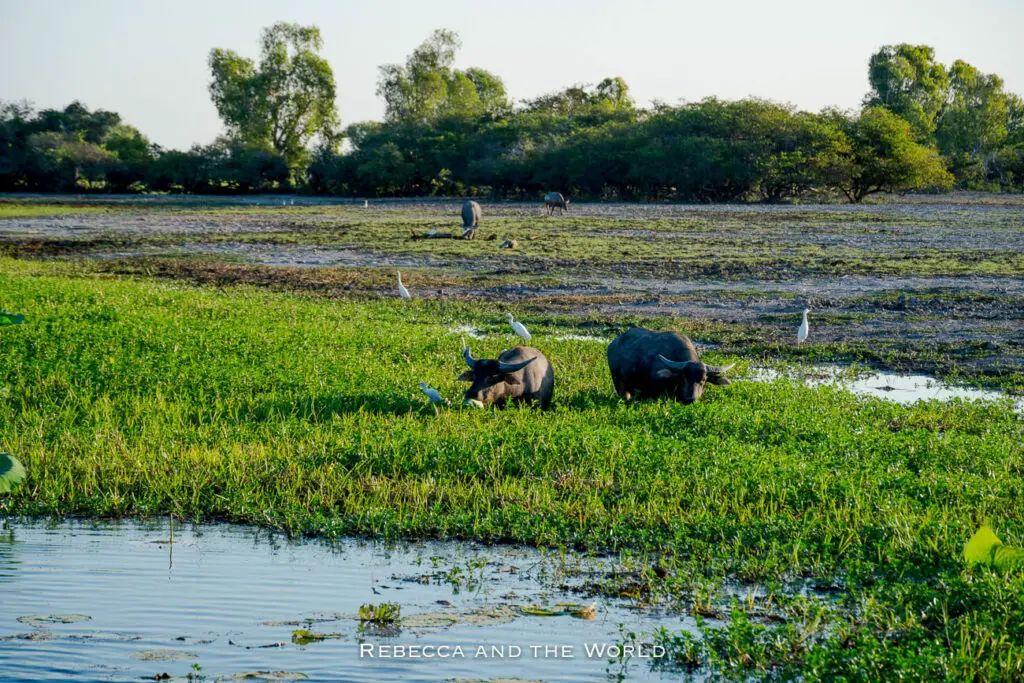
What to pack for Kakadu
Here are a few things you should bring on your visit.
- Kakadu Park Pass
- Hiking boots or sneakers
- Tevas or other water shoes – especially useful for the Maguk hike
- Water bladder (I prefer a water bladder to a bottle when I’m hiking)
- Sunscreen (at least SPF50+)
- Insect repellent
- Hat and sunglasses
- Swimming gear
- Pool noodles or inflatable – a must for the swimming holes!
- Food, snacks and plenty of water
How to get to Kakadu National Park
Kakadu National Park is located in the Northern Territory of Australia, approximately 150km southeast of Darwin. There are a few ways to get there:
- Self-drive – this is the most popular option and gives you the flexibility to explore at your own pace. Rent a car in Darwin (or in Katherine ) and make the 1.5 hour drive to the park entrance (it’ll take you about 2.5 hours to get to the Bowali Visitor Centre). Avoid driving to Kakadu from Darwin in the dark – there are lots of animals, including wild buffalo, that cause hazards.
- You can also visit Kakadu on an Adelaide to Darwin road trip or a Top End road trip !
- Organised tour – there are several companies offering day trips or multi-day tours to Kakadu from Darwin.
Darwin to Kakadu tours
There are a few Darwin to Kakadu day trip tour options . Most include pick up and drop off from your accommodation in Darwin, as well as lunch and knowledgeable guides.
Best time to visit Kakadu
The best time to visit Kakadu National Park is during the dry season, which runs from April/May to October. This is when the weather is cooler and there’s less chance of heavy rains or floods. Some parts of the park may still be closed earlier in the season, so July/August/September are good months to visit.
However, Kakadu during the wet season (October to April) can be spectacular. The monsoonal rains mean the waterfalls are at their thundering best and animals are on the move. Just be aware that some areas of the park may be closed during this time due to flooding.
The Bininj/Mungguy actually recognise six different seasons , and have used their knowledge over thousands of years to live in harmony with the land.
Keep in mind that during the dry season is when burn-offs can take place. This is an important part of caring for the land. There were burn-offs when we were there, but most of these happened overnight so we only had to deal with a bit of smoke.
Time your trip with the Taste of Kakadu festival , which celebrates bush food. Over a weekend, you can experience traditional bush tucker, cooking demonstrations, music and cultural performances. In 2024, the festival will be 24-26 May.
The Kakadu Dird (full moon) Feast also looks fabulous. A four-course meal under the stars celebrates bush tucker and the six seasons of Kakadu.
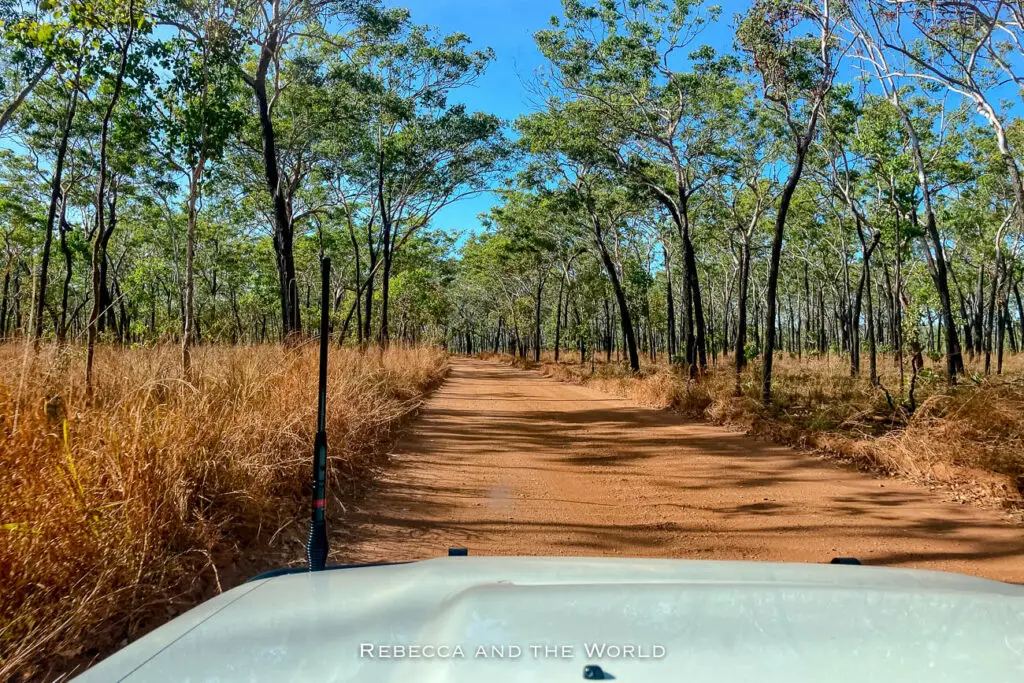
Where to stay in Kakadu
Here are options for accommodation in Kakadu National Park – I’ve included places to stay across the park.
Camping in Kakadu
I highly recommend camping in Kakadu – there’s nothing quite like the tranquility of the evening, when the only sounds are birds and insects, and the occasional bellow of a buffalo.
There are a number of campgrounds located throughout the park. National park-run campsites come in three types: managed sites (with showers, toilets and an on-site manager), unmanaged sites (pit toilets, pay to an honesty box) and free sites (no amenities). You need to bring your own drinking water to all types of campsites.
During our time in Kakadu, we stayed at Djarridjin, Mardukal and Maguk campgrounds. A full list of campgrounds can be found online .
There are also campsites at some of the hotels, including Cooinda Lodge and Aurora Kakadu Lodge .
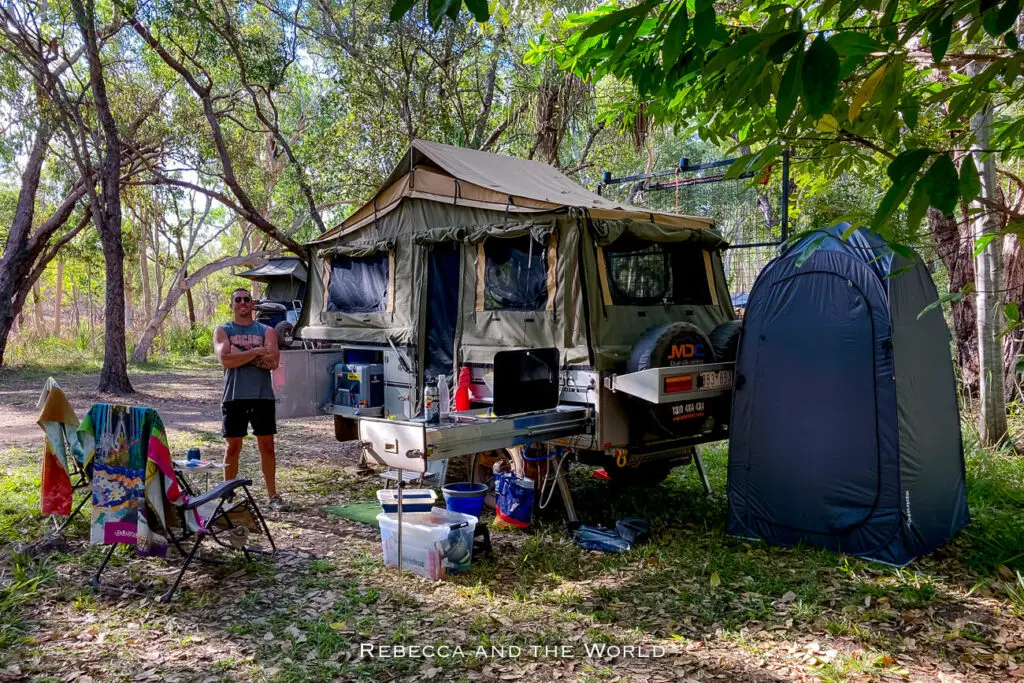
Kakadu hotels
Don’t have camping gear or want a bit of luxury? No worries – there are several hotels throughout the park.
The majority of hotels are in Jabiru:
- Mercure Kakadu Crocodile Hotel – in the shape of a croc, this full-service hotel has a pool that you’ll need at the end of a long day | Check prices online on Booking.com and Expedia
- Aurora Kakadu Lodge – has self-contained cabins (with AC) and lodge rooms, as well as powered and unpowered caravan and campsites. There’s a great pool and a bar/restaurant | Check rates online on Booking.com and Expedia
- Anbinik Kakadu Resort – has lovely suites and cabins, as well as “bush bungalows”, all of which are surrounded by lush vegetation | Check rates online
Cooinda Lodge Kakadu is further south. The resort has both hotel rooms and glamping tents, as well as access to a restaurant/bar, swimming pool, petrol station, shop and tours. | Check rates online on Booking.com or Expedia
Where to eat in Kakadu
Bring plenty of snacks with you – and if you’re camping, bring all your food and water as the stores at Jabiru and Cooinda Lodge are unsurprisingly pricier than supermarkets in Darwin.
The Manjmukmuk Restaurant and Bar at the Mercure Kakadu Crocodile Hotel in Jabiru has the usual hotel fare – but you can also try crocodile, barramundi or even buffalo curry.
At Cooinda Lodge, Barra Bar and Mimi’s Restaurant have dine-in and takeaway options. We had some fish and chips there and they were fine, if a little overprices (to be expected). At night during the dry season, a few food tents open and sell smoked meats and fish and chips to enjoy alongside the live music.
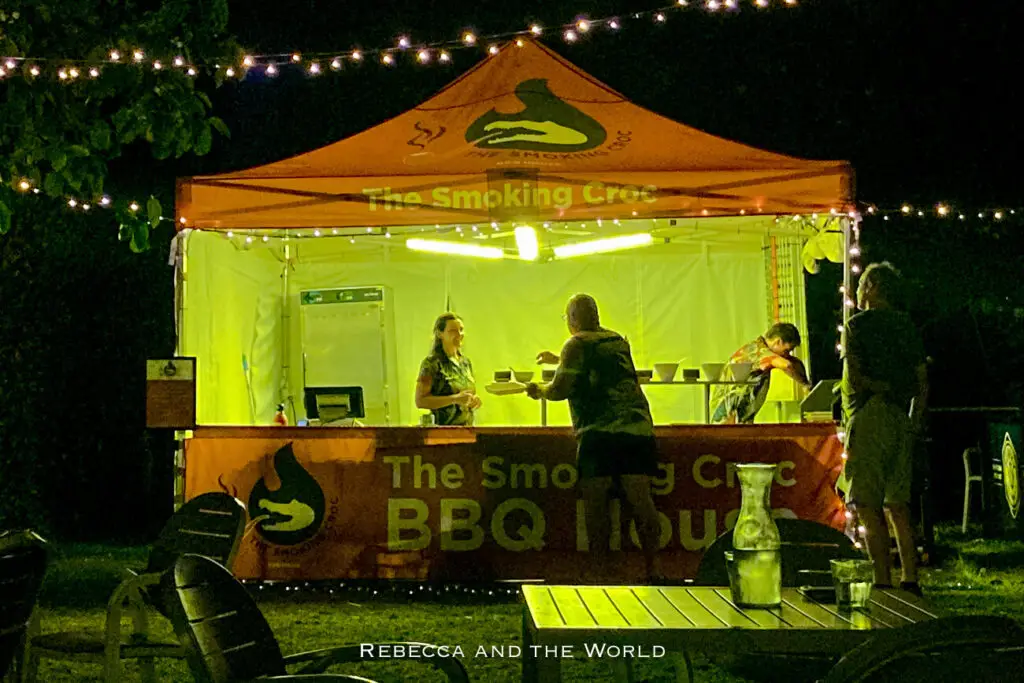
Wrap up: Things to do in Kakadu
Kakadu is one of the most stunning places to visit in the Northern Territory – and Australia. But it is huge, so you really do need to plan your trip there. Depending on how much time you have, pick a few areas and plan your Kakadu activities around those.
And while you may have a long to-do list while you’re here, make some time to simply relax in nature and appreciate the beauty of this World Heritage Site. It truly is a magical place.
What to do in Kakadu: FAQs
How many days do i need in kakadu national park.
At least 3 days are needed to see the highlights of Kakadu National Park. But ideally you should plan for a week to fully explore the area.
Are there crocodiles in Kakadu National Park?
Yes! There are more than 10,000 estuarine (saltwater) crocodiles in Kakadu. But salties can also be found in fresh water (something I learned while I was in Kakadu) so don’t think that there are no crocs there if you’re swimming in fresh water. Stay away from water unless a ranger has advised it’s okay to swim there. While rangers are always looking out for and removing crocodiles, you do enter the water at your own risk.
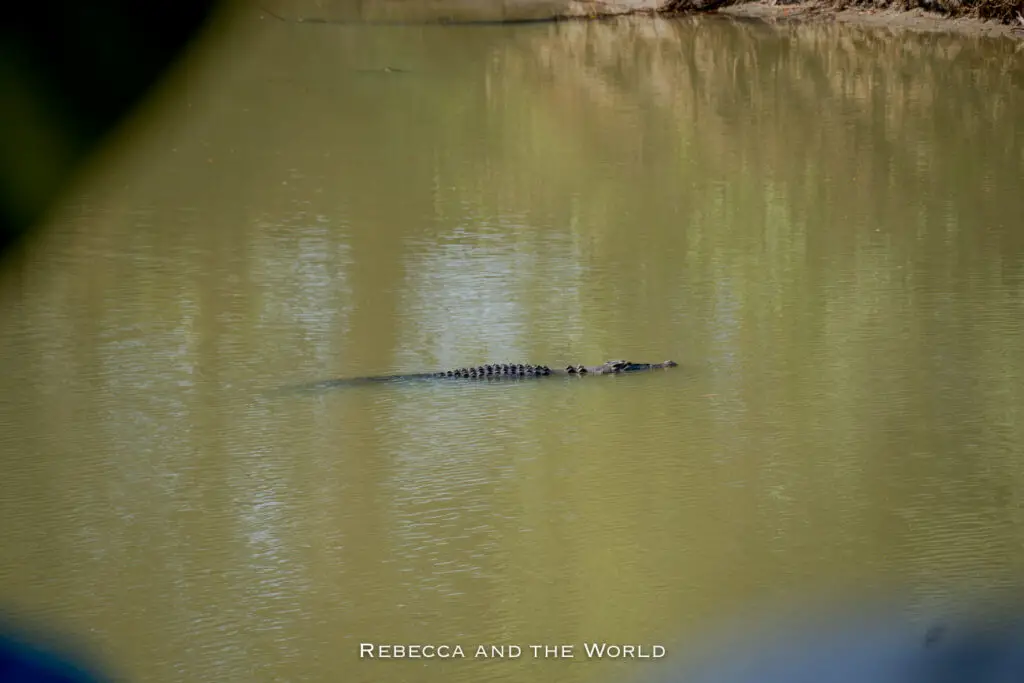
Do I need a 4WD for Kakadu National Park?
A 4WD isn’t necessary for most of the main attractions in Kakadu National Park. You can see most of the main sites I’ve listed in this article with a 2WD. However, there are some areas where you’ll need 4WD, like Jim Jim Falls and Maguk. If you’ve rented a 2WD , check with your rental car before driving on any 4WD tracks – some rental companies won’t let you take 2WD cars off road.
Can I visit Kakadu in the wet season?
Yes, you can visit Kakadu National Park in the wet season (October to April). In fact, it can be a stunning time to visit, when the waterfalls are at their peak and the rivers have flooded. Just be aware that some roads and sites may be closed due to flooding, and swimming may be restricted due to increased risk of crocodile encounters. Check the Kakadu website for closures.
Is Kakadu better than Litchfield National Park?
It’s difficult to compare Kakadu and Litchfield National Parks , as they’re both so different! While Kakadu is known for its vast wilderness, croc spotting and Aboriginal culture, Litchfield is the ultimate stop for stunning waterfalls and swimming holes. If you have time, it’s worth visiting both parks. Plus, with only about two hours’ drive between the two parks, it’s easy to do so. Other notable national parks in the area include Nitmiluk (Katherine Gorge) and Gregory National Park.
Did you find this article helpful? Consider buying me a coffee as a way to say thanks!
Have you been to Kakadu National Park?
Related posts
Before you leave… you might like these other Australia travel articles:
- The ultimate guide to Litchfield National Park
- The best things to do in Darwin, NT
- The ultimate guide to Nitmiluk National Park
- How to plan an epic Adelaide to Darwin road trip
- The best things to do in the NT
- The ultimate Top End road trip
- How to spend a few days in Alice Springs
- How to plan an epic Central Australia road trip
AUSTRALIA TRIP ESSENTIALS
- Book your flight to Australia online with Skyscanner . I like this site because it shows me which dates are cheaper.
- Find a great hotel in Australia. Check prices on Booking.com and Expedia online.
- Check out the huge range of day tours throughout Australia on GetYourGuide or Viator . There’s something for everyone.
- A copy of the Lonely Planet guide to Australia will be handy.
- One thing I always purchase is travel insurance ! Travel Insurance Master allows you to compare across multiple policy providers, while SafetyWing is great for long-term travellers and digital nomads.
- Pack sunscreen (look for SPF50 or higher), a hat and sunglasses because the sun is hot!
PIN IT FOR LATER: VISIT KAKADU NATIONAL PARK
Save this guide to Kakadu National Park to Pinterest for later.
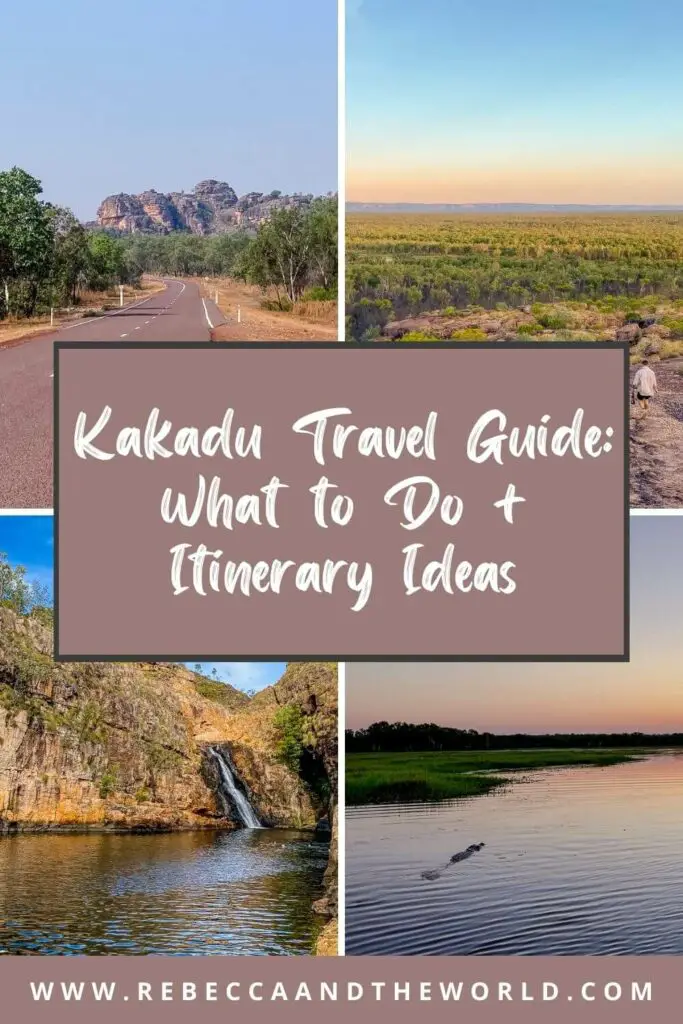
About REBECCA
I'm a travel junkie who started dreaming about seeing the world from a very young age. I've visited more than 40 countries and have a Master of International Sustainable Tourism Management. A former expat, I've lived in Australia, Papua New Guinea, Argentina and the United States. I share travel resources, tips and stories based on my personal experiences, and my goal is to make travel planning just that bit easier.
Leave a Comment Cancel reply
MORE INFORMATION
ABOUT WORK WITH ME CONTACT PUBLISHED WORK
AFFILIATE DISCLOSURE
AS AN AMAZON ASSOCIATE I EARN FROM QUALIFYING PURCHASES
© 2024 REBECCA AND THE WORLD
Privacy Policy
I ACKNOWLEDGE THE WURUNDJERI AND BOON WURRUNG PEOPLE OF THE KULIN NATION AS THE TRADITIONAL OWNERS OF THE LANDS AND WATERWAYS OF THE AREA I LIVE ON. I PAY MY RESPECTS TO ELDERS PAST AND PRESENT AND CELEBRATE THE STORIES, CULTURE AND TRADITIONS OF ALL ABORIGINAL AND TORRES STRAIT ISLANDER PEOPLE ACROSS AUSTRALIA.

- Privacy Overview
- Strictly Necessary Cookies
This website uses cookies so that we can provide you with the best user experience possible. Cookie information is stored in your browser and performs functions such as recognising you when you return to our website and helping our team to understand which sections of the website you find most interesting and useful.
Strictly Necessary Cookie should be enabled at all times so that we can save your preferences for cookie settings.
If you disable this cookie, we will not be able to save your preferences. This means that every time you visit this website you will need to enable or disable cookies again.
Awesome, you're subscribed!
Thanks for subscribing! Look out for your first newsletter in your inbox soon!
The best things in life are free.
Sign up for our email to enjoy your city without spending a thing (as well as some options when you’re feeling flush).
Déjà vu! We already have this email. Try another?
By entering your email address you agree to our Terms of Use and Privacy Policy and consent to receive emails from Time Out about news, events, offers and partner promotions.
Love the mag?
Our newsletter hand-delivers the best bits to your inbox. Sign up to unlock our digital magazines and also receive the latest news, events, offers and partner promotions.
- Things to Do
- Restaurants
- Arts & Culture
- Coca-Cola Foodmarks
- Los Angeles
Get us in your inbox
🙌 Awesome, you're subscribed!

The ultimate guide to Kakadu National Park
How to do a trip to Australia's biggest national park right

If you’ve ever dreamt of exploring the land before time (friendly dinosaur babies not guaranteed), boy, is there a place out there for you: Kakadu National Park . It's a World Heritage Site and Australia's biggest national park. Tucked into the Top End of the Northern Territory, just a two-and-a-half-hour drive from Darwin, Kakadu is a powerful place with a powerful history. The traditional land of the Bininj and Mungguy people and home to 19 different clan groups, Kakadu has been a sacred place of living and ceremony for Indigenous people for 65,000 years. Covering 20,000 square kilometres, Kakadu is a wild land rich with tiny yellow butterflies, rolling lightning storms, ancient rock art galleries, immense red gorges and deep blue pools, and its primordial wealth of life is something that has to be felt to be truly believed. A trip to Kakadu is one that makes you fall deep, and it will stay firmly within you long after you leave.
Here are the coolest things you can do, the best places you can stay, and the most delicious things you can eat while you throw yourself into the adventure of a lifetime.

What's the best time to go?
In this far northern part of Australia there are six seasons, with each one bringing something wonderful to the table. The dry season is the most popular (and arguably the best) time to hit up Kakadu, with most of the attractions open and free from the big floods that come through in the wet. If you like cooler weather and low humidity head north from mid-June to mid-August in Wurrkeng , the cold weather season. While the rest of Australia is gripped by big-time winter shivers, Kakadu is still balmy, with daily temps averaging 30 degrees by day and 17 degrees by night. The floodplains are dry, visitor sites are open for business, and bird lovers can see thousands of rare water birds frolicking in the shrinking billabongs. If you like yourself a bit more heat, go in Kurrung – the hot dry season. Spanning from mid-August to mid-October, this is the busiest time of year in Kakadu, when the average temperature ranges from 23 to 37 degrees. The days are tropically hot, with the land overflowing with colourful wildflowers and sparkling waterfalls that you can (sometimes) swim in. Big yes.
What are the coolest things to do?

First, get acquainted at Bowali Visitors’ Centre
Make this your first stop before plunging into the wilds of the national park. Kakadu is a pretty massive place, so getting the ropes before tackling it head-on is a good idea. Located off the Kakadu Highway in Jabiru, this is an excellent place to refresh after a long highway drive, with lush greenery and a café welcome sights for weary travellers. Head into the gorgeous visitor’s centre to chat to the friendly staff, get an idea of where you’d like to go on your trip, and wander through the very cool resident museum, where you can squiz a crocodile skeleton and a giant olive python (spoiler: not a live one).
You’ll also need to buy a national park pass before entering Kakadu .

Peruse art and sip coffee at Marrawuddi Arts & Culture Centre
A seven-minute drive from Bowali you'll find this not-for-profit Aboriginal art centre in Jabiru. This beautifully restored bakery painted in various shades of pink, with a pretty epic mural out the back, features an air-conditioned exhibition area and workspace that showcases the work of more than 400 artists from in and around Kakadu. You can peruse and/or purchase all the paintings, weavings, printed shirts and jewellery on display, meet the artists as they work on their works, and (if the caffeine craving calls) pick up a bloody good cup o’ joe from the resident café. It's owned and governed by Mirarr Traditional Owners, and all proceeds here go towards contributing to Gundjeihmi’s community development initiatives.

Gaze at ancient rock art and watch the sunset at Ubirr
A 30-minute drive from Jabiru down the Arnhem Highway/ Oenpelli Road, you’ll be blessed with a front-seat row seat to some of the most incredible rock art on the planet, as well as a pretty mind-blowing place to watch the sunset. Ubirr is home to two ancient Indigenous rock art galleries that can be explored via an easy one-kilometre loop track, and the best time to visit during the dry season is around 4pm, when the light is golden and the heat of the day is gone. For the best experience, definitely go with an Indigenous guide. We recommend the incredible Victor Cooper , a Bininj man who runs Ayal Aboriginal Tours Kakadu . A former Indigenous ranger in Kakadu, Cooper specialises in translating the significance of the rock art and historic sites at Ubirr. Keep your eyes peeled for etchings of a Tasmanian tiger, the ethereal mimi spirits, and a musket from the 1800s. After you’ve had your art fill, clamber up the rocks to find a prime spot to sit and watch the sunset drench the stretching flood plains. It is always spectacular and never the same twice.

Bask in the wonders of Jim Jim Falls
These majestic 200-metre cascades at Jim Jim are renowed for their power and jaw-dropping splendour. In the wet season, getting up close by foot is basically impossible, which is why (if you've got a bit of dough in the bank) you can do a pretty incredible scenic flight overhead. If, however, you'd rather go in for free and also go for a life-changing swim in the process, then we suggest you hit Jim Jim up in the dry for maximum bang for your buck. Just 43 kilometres down the Kakadu Highway from Bowali, this is a four-wheel-drive-only trip over 10 kilometres of soft sand – so make sure you're equipped. However, once you clear this almighty adventure, you're in for a treat. Clamber across a 900-metre track until you get to the plunge pool. Swim beneath the deep red Arnhem Land escarpment in heart-rendingly clear water, bask on the white sandy beaches, and bathe in the pure light. Magic.

Feel the silence at sunrise (or sunset) at Nawurlandja Lookout
If you want another good sunrise (or sunset) spot, look no further. The lookout is a 30-minute drive from Jabiru, so you don’t need to get going too early to catch an epic look at first light. Get on the one-way walking track and clamber up a slight rocky incline (it is a little steep in parts; you’ll need to be of moderate fitness) and head up to the rock platform that overlooks an impossibly wide stretching view across a bright green savannah, the Anbangbang Billabong and the ochre cliffs of the Arnhem Land escarpment. Keep your eyes peeled for rock wallabies and let yourself dissolve into the soft pastel silence.

Take a crystal clear plunge at Maguk Gorge
Perhaps one of the most spectacular things to do in Kakadu, this incredible natural gorge is one of the only places you can swim in Kakadu. Despite having a few ‘Beware: Crocodile' signs scattered around, this gorge is an incredibly popular swimming spot, and for good reason. Only accessible by four-wheel-drive and an hour's drive from Cooinda, it is at the end of a short monsoon rainforest walk that requires a low to moderate level of fitness. Walk past rainbow pittas, emerald doves and tiny yellow butterflies that dart over the tropical track. Soon you will arrive at the main event: a crystal-clear plunge pool and massive sparkling waterfall, all set within a dazzling stone amphitheatre. Swim in the glittering turquoise water, sunbake on the smooth rocks, and lie under the fresh tumbling cascades. This place is, by all definitions, 100 per cent paradise.

Explore the golden rocks and 22,000-year-old paintings at Burrungkuy (Nourlangie)
Once the traditional land of the Warramal people who have now all passed on, this deeply sacred and ancient site is now cared for by neighbouring clans. A 30-minute drive from Cooinda Lodge, this place is home to intricate rock art and human artefacts that date back more than 22,000 years. Filled with heritage-listed art, including the world-famous Lightning Man , this extraordinary place is steeped in primordial history, stories and unique wildlife that you can soak up at your leisure. Either amble through the Nanguluwurr art site walk, clamber up a moderately steep track to the Kunwarddehwardde lookout to gaze out at the wild ridges of the Kakadu escarpment or walk around the shady Anbangbang Billabong. To maximise your viewing experience of these intricate rock galleries and the stunning natural formations surrounding them, we recommend Victor Cooper from Ayal Aboriginal Tours , whose deep knowledge is unparalleled.

Drift down the river with Yellow Water Cruise
A 10-minute drive from Cooinda Lodge, this incredible river cruise on the Yellow Water Billabong along the heritage-listed South Alligator River takes dreamy adventure to a whole new level. There are six departures per day, and the most popular times are sunrise and sunset, this being the best time to see wildlife. We recommend going at dawn, when the air is soft and oceanic and all the animals are starting their day. See colossal crocs swimming through fields of pink water lilies, sea eagles diving for fish, and tiny bird lovers hopping across gigantic floating lily pads. With one of the dynamic and hilarious Yellow Water guides driving the boat, you can be confident that not a single animal fact, sneaky croc or colourful story will pass by unaccounted for.
Where are the best places to stay?
There are many places to lay your head in Kakadu. Camping aside (and trust us, the options here are plentiful ), you have the choice of a few more luxe accommodation options that are a rich Kakadu experience in themselves.

Sleep dangerously at Mercure Kakadu Crocodile Hotel
Shaped like a gigantic saltwater crocodile, this wild hotel is a quintessential embodiment of the Northern Territory’s irreverently irresistible spirit. Situated in the township of Jabiru, this croc-shaped paradise (spoiler: there are absolutely no real crocs here) is an excellent base from which to explore Kakadu, with it within an hour's drive of Ubirr, Nawurlandja Lookout and Burrunkuy (Nourlangie). All the comfy rooms face outwards into an internal courtyard and shady oasis of a pool. Guests get the choice of a standard room (one queen, or two doubles), a superior (a queen and a single or two doubles) , or a courtyard superior (a big double or queen bed and seating outside in the courtyard area). All rooms have big white beds, comfy pillows and easy courtyard and pool access. With an on-site restaurant, big private pool, shaded seating areas and lovely bright rooms, this (slightly) wacky accom is a comfortable place to retreat to after a day of adventuring. Plus, you can play the fun game of where exactly within the big croc your room is located. We got lower belly. It's pretty cute.

Glamp in glamour at Cooinda Lodge
An oasis of glamping tents, cabins and shady lush campground, this village-like property is tucked away right by the Yellow Water Billabong. In a national park as vast as Kakadu, the need for petrol, food, water and shelter is more pressing than most. At Cooinda Lodge, you can find all of the above in one space, and there is a variety of accommodation options available. Whether you glamp in one of the elevated outback retreats, sleep in one of the luxe air-conditioned lodge rooms that accommodate up to four people (and come with a mini-fridge, squishy pillows and TV) or camp in a luxury tent, you’re in for a simply gorgeous time.
Where are the best places to eat?

Food options are a little scarce once you dip into the wilds of Kakadu. You can either come along fully stocked with your own extensive provisions, or, you can rely on the few foody establishments that are scattered throughout the park for sustenance. Here, we’ve gathered some of em’ together for you.
Anbinik Restaurant
Located in Jabiru, this fresh Thai restaurant is the only one of its kind in Kakadu. Serving up zesty pad thais and divinely thirst-quenching lime juice frappes, this sleek timber joint is a delicious and shady nook providing a yummy variety of foods. You can get yourself a classic toastie and a wedge of cheesecake, as well as a delightful variety of zingy Thai options, with them doing dinner every night during the dry season, and breakfast, lunch and coffee from Tuesday to Sunday. We recommend.
Barra Bar & Bistro
Cooinda Lodge’s on-site restaurant, this cosy timber paradise is full of golden light and good times. In the morning, you can get stuck into a succulent breakfast buffet and swill back delicious barista-made coffees in ‘Mimi’s Restaurant’, while at lunch you can snaffle down a proper pub lunch, with all the classics up for grabs, alongside ice-cold schooners. For dinner, get involved with the ‘Taste of Kakadu’, a tasting platter featuring smoked and marinated crocodile, seared buffalo and chargrilled kangaroo with Kakadu plum chilli sauce and bush tomato chutney on the side. The food is tasty, the service is on-point, and the vibes extraordinarily comfortable. Note: the platter is best when shared.
Escarpment Bar & Restaurant
The Mercure Kakadu Crocodile Hotel’s resident restaurant, all the main meals are covered here. You can guzzle your way through a breakfast buffet, a rather pricey cold lunch buffet (just salads, bread and cut meat), or, the star in this particular crown: dinner. With an emphasis on locally sourced flavours and produce, you can eat your way through buffalo, crocodile balls with aioli, seared barramundi steak and finger lime panna cotta in the cavernous formal dining room.
Keen to keep travelling through the Great Southern Land? Check out this list of the 25 very best things to do on your trip across Australia.
An email you’ll actually love
[image] [title]
Discover Time Out original video
- Press office
- Investor relations
- Work for Time Out
- Editorial guidelines
- Privacy notice
- Do not sell my information
- Cookie policy
- Accessibility statement
- Terms of use
- Modern slavery statement
- Manage cookies
- Time Out Market
Time Out products
Explore Kakadu National Park
Plan your trip to kakadu national park: best of kakadu national park tourism.

Discover Kakadu National Park

Trending in the forums
Kakadu National Park Is Great For
Full-day tours.

The great outdoors

- Kakadu National Park
- Things to do
- Itineraries

Bushwalker reading map
Kakadu is one of the largest national parks in Australia, covering a staggering 20,000 sq km. With that much land to cover, and so many out-of-this world sights to take in, planning your trip can be confusing.
Our itineraries have been designed by people who live and work in Kakadu, and have helped thousands of visitors get the most out of their holiday.
We’ll make sure you tick off all the iconic sites and experiences. You’ll see the world-class rock art, walk through pristine bushland and absorb the true spirit of the land.
Kakadu is not something that should be crammed into a day! It’s a remote wilderness that should be savoured – Kakadu will change you.
Tip: The Traditional Owners recognise six seasons in Kakadu. But for trip-planning purposes it’s best to break them into the dry season (April to October) and tropical summer (November to March).
Choose your own adventure
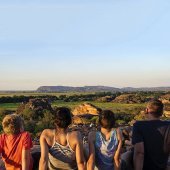
Nature and Culture encounter – 3 days
Immense beauty, diverse wildlife and rich heritage on a three day 2WD outback break.

Kakadu adventure – 5 days
Discover Kakadu's natural beauty, diverse wildlife and rich heritage on this five day outback journey of a lifetime.

The living landscape – 7 days
Visit the world’s oldest living culture, feel the spirits on Country and discover restricted areas of rich beauty.

Tropical summer break – 3 days
World-class rock art, spectacular wetlands and a mind-blowing view of the park from above.

Tropical summer adventure – 5 days
Thundering waterfalls, spectacular floodplains and astonishing wildlife. Connect with nature and an ancient living culture.
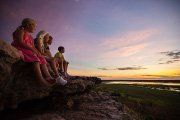
Take the first step
A journey of 1000 miles begins with a single click.
Enter your email to get free trip planning advice from Kakadu rangers.
- Australian Government, Parks Australia
- Kakadu is dual-listed on the UNESCO World Heritage List for its outstanding natural and cultural values
- Gold, Major Tourist Attraction, 2017 Australian Tourism Awards
- Buy park pass
- Discover Kakadu
- For schools
- Shops and facilities
- Plan your trip
- Ranger tips
- When to come
- Getting here
- Park passes
- Visitor centres
- Where to stay
- Hotels and cabins
- News and alerts
- Latest news
- Kakadu Access Report
- Media centre
- Frequently asked questions
- Growing Tourism in Kakadu
- Norfolk Island
- Christmas Island
- Pulu Keeling
- Australian National Botanic Gardens
- Australian Marine Parks
© 2013–2024 Parks Australia (Commonwealth of Australia)
We acknowledge the Traditional Owners of country throughout Australia and recognise their continuing connection to land, waters and culture. We pay our respects to their Elders past, present and emerging.

Visiting Kakadu National Park from Darwin: Attractions
Written by Karen Hastings Updated Mar 9, 2021 We may earn a commission from affiliate links ( )
About a three-hour drive from Darwin , World Heritage-listed Kakadu National Park is one of the most awe-inspiring wilderness areas on the planet. The park is one of the top attractions in Australia's Northern Territory , and it's one of the most popular places to visit from Darwin.
Kakadu is huge. At almost half the size of Switzerland, it's the largest national park in Australia , with more than 20,000 square kilometers of rivers, monsoon forests, mangroves, tropical woodlands, wetlands, and an astounding array of wildlife.
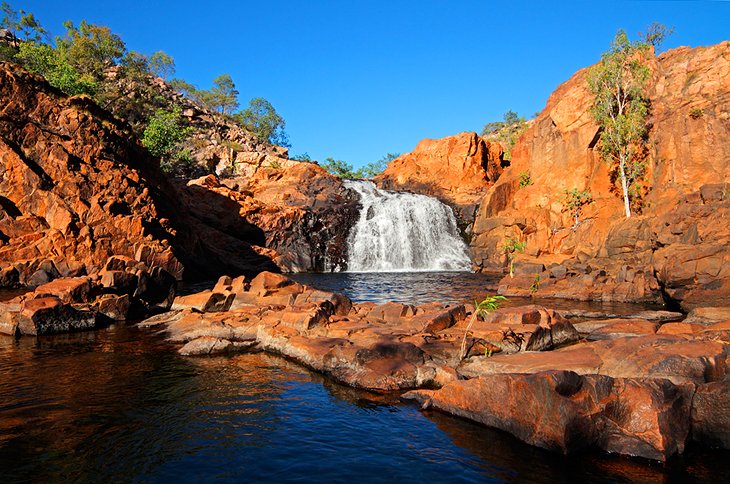
Despite its vast size, visiting Kakadu National Park from Darwin is easy on a self-drive tour. Once you arrive, you can book cruises around the wetlands. Rangers also offer free guided tours during the dry season, and aboriginal-led tours provide a window into the cultural heritage of the park.
If you have limited time and/or prefer to travel with an experienced guide, it's a good idea to choose one of the organized Kakadu tours from Darwin. Although you can explore the park on a day trip from Darwin, it's better to spend at least two to three days here so you can truly appreciate its contrasting landscapes, complex ecosystems, and rich aboriginal history.
Once you arrive in the park, popular things to do in Kakadu include fishing, boating, birding, croc-spotting, hiking, swimming, and camping.
When to Visit Kakadu National Park
Self-drive tours from darwin, organized tours in kakadu national park, professional tours to kakadu from darwin, kakadu landscapes, kakadu aboriginal heritage and rock art, kakadu walks and hikes, kakadu wildlife, kakadu plants, kakadu waterfalls, kakadu visitor centers, tips and tactics: how to make the most of your visit to kakadu national park.
The best time to visit Kakadu from Darwin is during the dry season, from mid-June to mid-August. Although the wet season (November to March) can be trying, a visit at this time is an impressive experience, with thunderstorms, flooded waterholes, tumbling cascades, and tumultuous rivers. However many roads, tracks, campgrounds, and picnic areas are closed due to flooding.
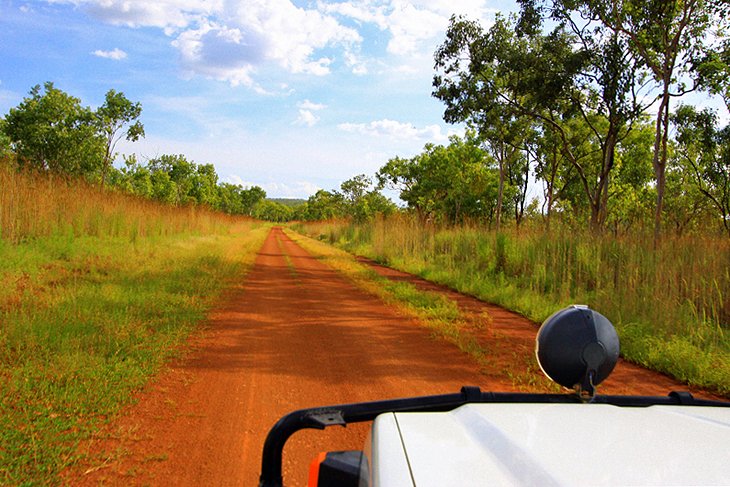
The driving distance from Darwin to Kakadu is about 250 kilometers along the Arnhem Highway on sealed roads. This three-hour drive will bring you to Jabiru , the main settlement and supply center in the park .
On the way, you can enjoy an exhilarating croc cruise on the Adelaide River, about an hour from Darwin, and see these formidable creatures leap from the water. You can also stop by the Window on the Wetlands visitor center to learn more about the ecology of the wetlands in Kakadu National Park and the region's aboriginal history.
From Jabiru, the roads are also sealed to many of the park's top attractions, like Yellow Water and the aboriginal paintings at Ubirr and Nourlangie . If you want to venture further afield and see some of the magnificent waterfalls and more remote attractions, a 4WD is recommended. Most of the big car rental companies have offices in Darwin, and fuel is available at Kakadu Resort (at South Alligator), Cooinda, Jabiru, and Goymarr Tourist Park. Check current road conditions before you head out.
Once you arrive, you can tour the park in your own vehicle or on foot. To see aboriginal rock art, plants, and wildlife up close, you can hike the vast network of trails and enjoy the view from elevated lookouts along the way. To cover larger distances, driving is recommended.
If you have time, you might also want to combine a visit to Kakadu National Park with Litchfield National Park , about a four-hour drive away. Litchfield is a more compact park than sprawling Kakadu, and the mostly sealed roads are easily negotiable in a 2WD vehicle.
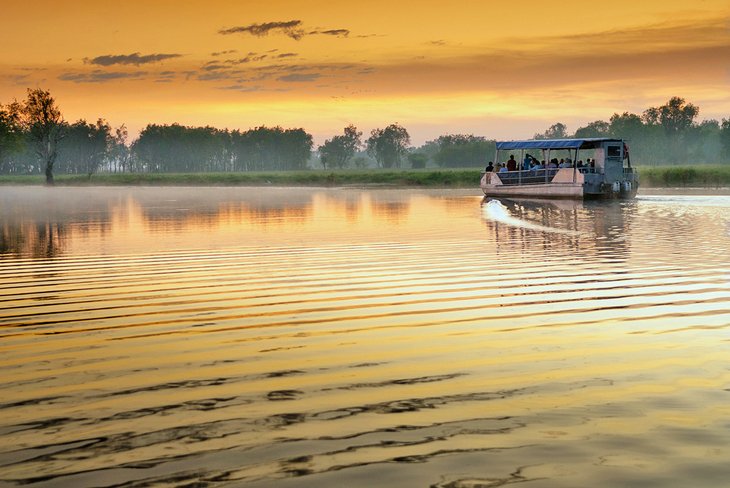
Once you arrive in the park, you can organize tours spotlighting specific areas.
Ranger-led hiking tours and cruises through the wetlands are a great way to learn more about the park and experience areas that are difficult to access. The Yellow Water Cruise in Kakadu is one of the most popular wetlands cruises. Owned and run by indigenous people, the 90-minute cruise is a great way to see some of the wetland wildlife, including crocodiles and a dazzling array of birds, from white-bellied sea eagles to kingfishers and jacanas. Choose your timing - from sunrise to sunset's golden hour. Photographers and birders, in particular, will enjoy this cruise.
The Guluyambi Cultural Cruise on Kakadu's East Alligator River is another excellent option. Aboriginal guides share fascinating information on the river's cultural mythology, the rich ecosystem, and traditional hunting techniques and uses for the plants and animals.
Another wonderful way to see the park is by air. Scenic flights offer an eagle's-eye view of the serpentine waterways and patchwork of floodplains - especially during the wet season, when areas are difficult to access and waterfalls gush over the escarpment. The Jabiru 60 Minute scenic flight , with a guided commentary, soars over key landmarks, including the Alligator River, Jim Jim Falls, and Magela Floodplains.
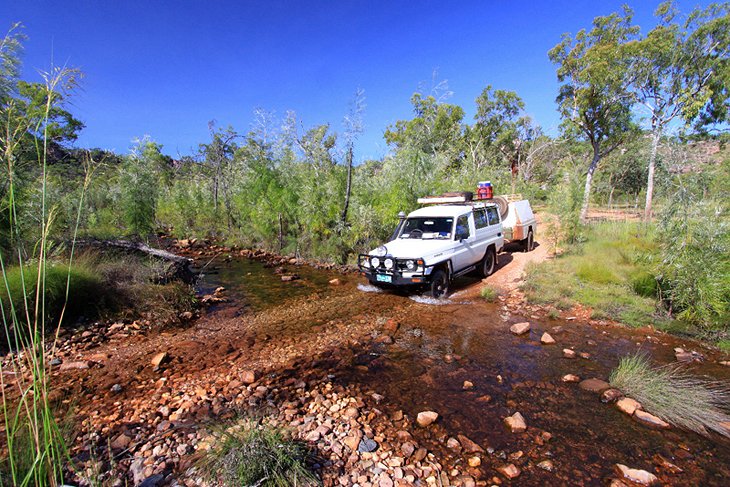
If you're short on time or want to relax and let an experienced guide do the work, a professional tour of Kakadu National Park from Darwin is a great option. Day trips and multi-day tours take you to the main attractions without the hassle of driving and finding your way. Small-group tours travel in comfortable 4WD vehicles, or you can travel by coach on a larger tour.
Many tours also offer the chance to visit Arnhem Land , a sprawling wilderness area adjacent to the park, which is home to the Yolngu aboriginal people and is only accessible with a permit.
If you're visiting Kakadu on a day trip from Darwin, the Kakadu, Nourlangie and Yellow Water Tour from Darwin is a great way to experience the park's highlights in a limited timeframe, including aboriginal rock art, waterways, and wildlife.
If you have more time, the 2-Day Kakadu and Arnhem Land Tour from Darwin also includes the park's main attractions, such as Nourlangie and a Yellow Water Cruise, and it adds a 4WD tour of Arnhem Land and the Mikinj Valley with an aboriginal guide.
To really absorb the park's natural beauty and cultural significance, the 3-Day Kakadu National Park and Arnhem Land Explorer Tour includes all of the attractions visited on the shorter tours, as well as an East Alligator River cruise. In Arnhem Land, you'll also visit sacred aboriginal sites and learn bush hunting techniques. These multi-day tours offer different standards of Kakadu accommodation to suit your budget.
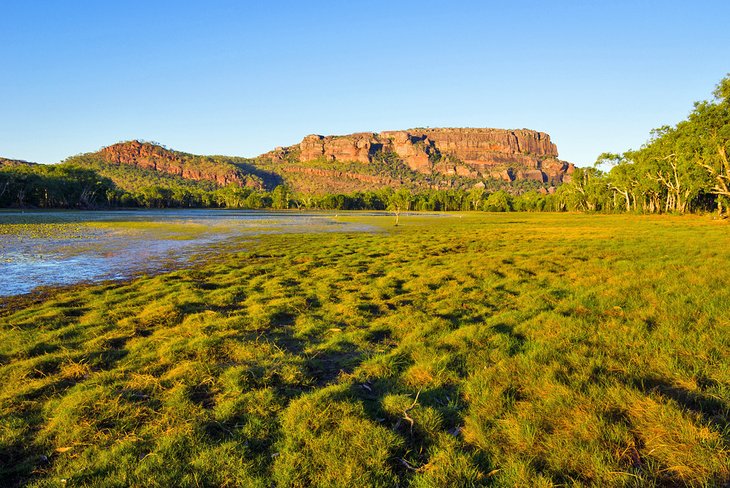
A place of timeless beauty, the park is a giant patchwork of contrasting landscapes. In the north is the tidal zone, where rivers flow to the sea. Monsoon rainforest lies in the gorges and on shady hillsides, where water nourishes the plants.
Farther inland, tropical woodland cloaks the gently undulating upland country and constitutes the greater part of the park. All the main roads run through this area, making it easy to access the sights on a road trip from Darwin. The dry shrubs and grasses here resemble the landscapes of Australia's arid interior.
In the south of the park, where stony upland areas are scattered with crags of granite, plants and animals from the wetter north and the arid interior flourish side by side. Much of the catchment area of the South Alligator River lies in this barren stone country.
Crossing the park diagonally, from the southwest to the northeast, is the escarpment of the Arnhem Land plateau. During the rainy season, waterfalls cascade over the lip of the escarpment to join the wetlands and rivers, which follow a winding course to the sea. During the dry season, the waterfalls and rivers dry up, leaving only rock pools and billabongs (waterholes in the river beds), where many animals come to drink. At the beginning of the dry season, small areas of grassland are deliberately burned to reduce the danger of large-scale fires.
These diverse landscapes are so beautiful that filmmakers shot many scenes for the popular Australian film Crocodile Dundee in Kakadu. The movie provided excellent publicity not only for the park, but for the entire Top End.
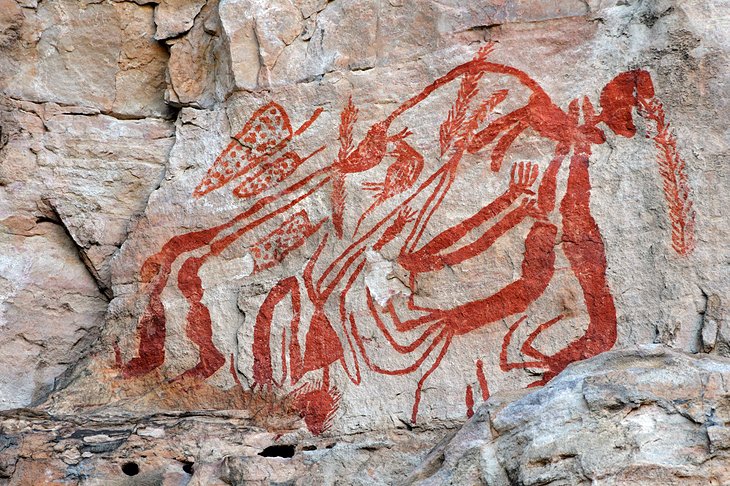
The name Kakadu comes from Gagadju, one of the languages spoken by the aboriginal tribes, who have lived in this region for at least 50,000 years. Today, more than half of the park belongs to these traditional owners, who jointly manage the area with Parks Australia.
A highlight of Kakadu (and one of the reasons for its World Heritage status) is the magnificent aboriginal rock art. Some of the paintings are more than 20,000 years old, providing a fascinating record of one of the oldest cultures on Earth.
Famous rock art sites include the Nourlangie Rock , south of Jabiru, and Ubirr (Obiri) Rock . Both sites comprise the most important assemblage of Aboriginal art in Australia and are among the park's top attractions.
Side by side, and sometimes superimposed, the paintings portray mythological figures, like the Rainbow Serpent and the Lightning Man, as well as "X-ray" pictures showing the skeleton and internal organs of animals such as barramundis, crocodiles, and turtles. The most recent paintings illustrate encounters with white settlers through representations of two-masted sailing ships, guns, horses, and buffaloes.
At Nourlangie, you can view paintings in the Anbangbang Gallery , or at Nanguluwur , a smaller gallery at the end of a 1.7-kilometer trail. At Ubirr, a one-kilometer circuit walk to view the paintings takes about 45 minutes. Allow an extra 30 minutes to enjoy panoramic views from the lookout. From June to September, rangers give talks at both Ubirr and Nourlangie.
Official site: https://parksaustralia.gov.au/kakadu/do/rock-art/
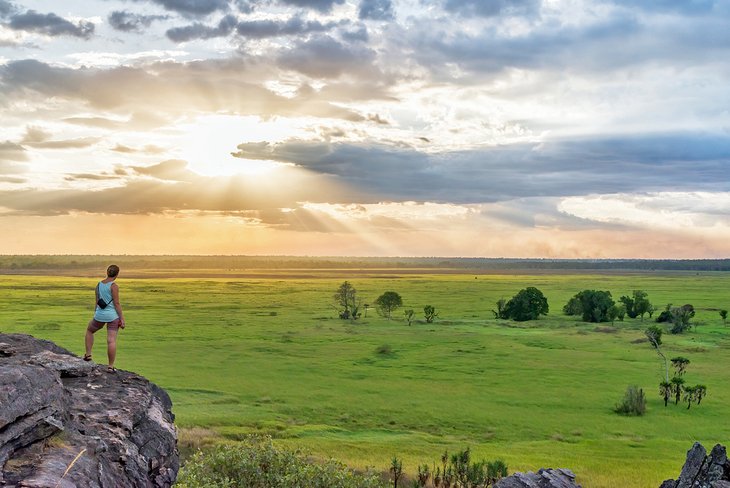
Kakadu's walks are divided into different regions, each offering contrasting landscapes and habitats. Accessibility varies depending on the weather.
If you're a first-time visitor to the park, a great introductory walk is the Jabiru to Bowali Track . The trailhead lies opposite the Gagudju Crocodile Holiday Inn and weaves through woodlands to the Bowali Visitor Centre . From May to October, rangers give free talks here.
In the East Alligator region, you can enjoy panoramic views from Ubirr, admire aboriginal rock art, and explore rainforest and rock pillars. In the South Alligator Region, birds abound around the billabongs and Mamukala Wetlands .
Walks in the Nourlangie region explore the aboriginal art galleries of Nourlangie Rock , as well as the beautiful Anbangbang Billabong. Also in this region, the Bubba Wetlands Walk encompasses tranquil lily-topped ponds.
The Yellow Water region is famous for its boat cruise through the floodplains, but you can also explore the billabong on the Yellow Water Boardwalk .
During the dry season, walks in the Jim Jim and Twin Falls areas lead to Kakadu's waterfalls, which slow to a trickle at this time of year. You can explore rugged gorges and refreshing plunge pools. During the wet season, sightseeing flights allow you to view the falls from the air.
In the Mary River region, bushwalks offer views of gushing waterfalls in the wet season, and sparkling waterholes when the rains cease and the dry season is in full swing.
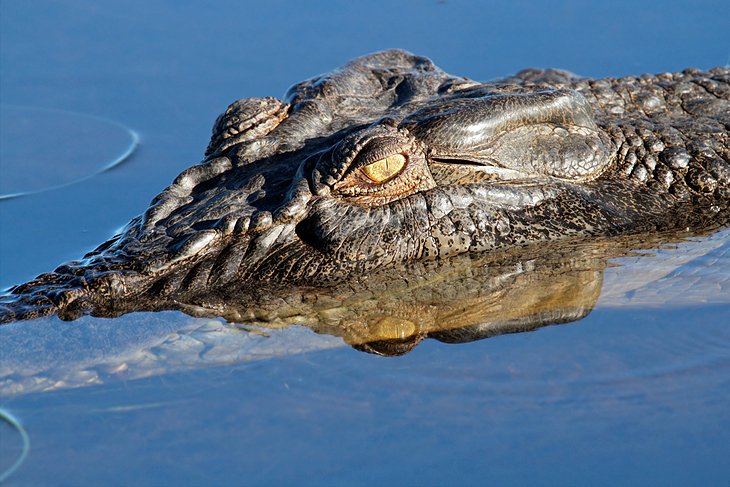
Kakadu National Park is home to a dazzling diversity of wildlife. A quarter of all the species of freshwater fish known in Australia swim in its waters. Animal lovers will also find more than 50 different species of mammals, including rock wallabies, bats, and the northern quoll, as well as a plethora of reptiles; the saltwater crocodile is the largest and most dangerous.
Birding in the park is highly rewarding. The wetlands are important staging posts for migratory birds and provide a home to countless water birds, including the magpie goose, brolga (a species of crane), and jabiru (black-necked stork).
To observe all this wildlife, you can explore the vast network of walking trails in the park. Crocodiles and water birds are best glimpsed by boat.
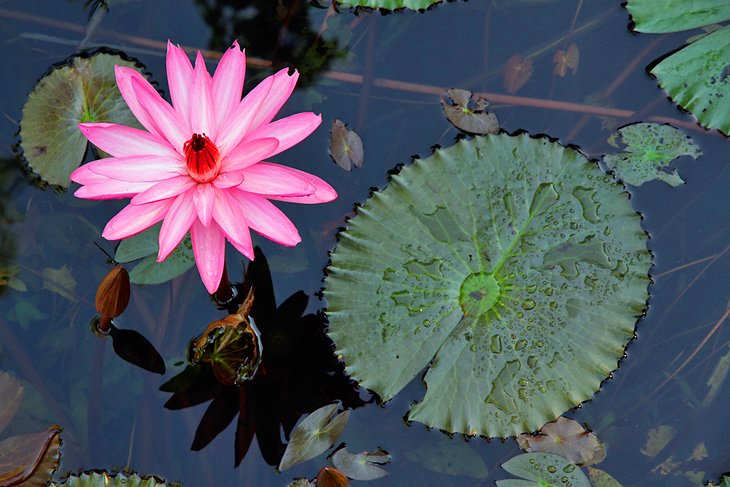
Kakadu protects more than 2,000 plant species - from water lilies to silver-leaved paperbarks. For thousands of years, Aboriginal people used some of these plants for food, medicinal purposes, and weaving materials.
One of the most distinctive and multi-purpose plants in the park is the corkscrew-shaped pandanus , which provides excellent material for weaving baskets and mats. Small animals take shelter under the dead leaves, and the plant's fruit and nuts are important food sources for both animals and people.
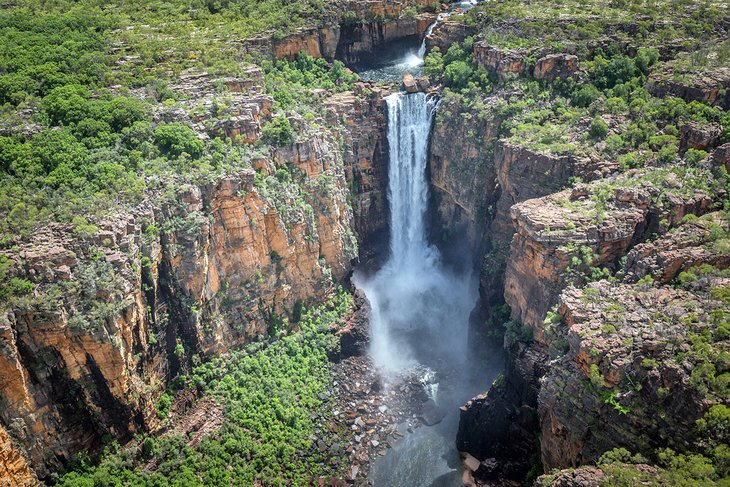
During Kakadu's wet season, water tumbles over the bare rocks and escarpment of the Arnhem Land Plateau creating magnificent cascades. Jim Jim Falls and Twin Falls in the southeast are perhaps the most famous falls in the park. After the rains, visitors can soar over the falls on a sightseeing flight.
In the dry season, when the falls slow to a trickle, the Jim Jim Plunge Pool Walk winds through monsoon forest to a deep waterhole. A great way to see Twin Falls is aboard the boat shuttle, which glides through the gorge from June through October. After the cruise, visitors can view the falls from a floating boardwalk.
Other waterfalls worth seeing include the Maguk Falls (to the south), and Gunlom (Waterfall Creek) accessible via a track, which is sometimes closed during the wet season. Check before departure. Motor Car Falls are accessible in the wet season, when Kakadu's larger falls are off limits.
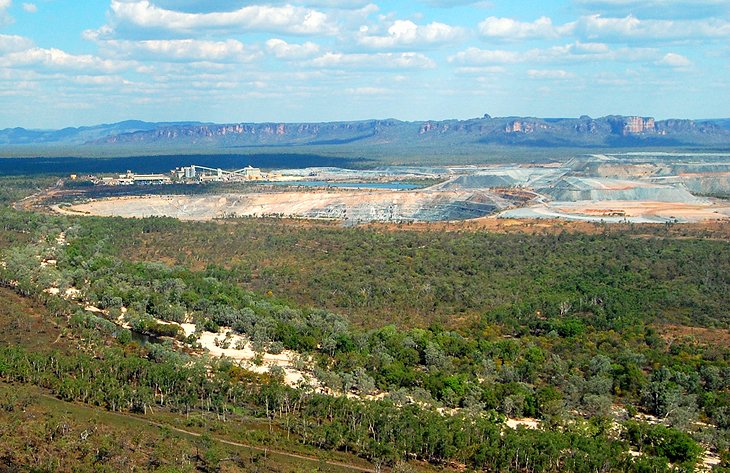
The settlement of Jabiru lies within Kakadu National Park near the Ranger uranium mine, which is slated to close in 2021. The popularity of the national park has made Jabiru an important supply and services center.
Jabiru's main attraction is the Mercure Kakadu Crocodile Hotel . Built in the shape of its namesake amphibian, 250 meters long and 30 meters wide, the hotel is particularly impressive from the air. Its architecture equates with the crocodile totem of the local Gagudju Aborigines.
Kakadu is home to two visitor centers with informative exhibits on the park. They are also a great place to pick up a Kakadu National Park map.
Bowali Visitor Centre, near Jabiru , is a great introductory stop for newcomers to Kakadu. Walk-through displays provide fascinating information about the park, and you can also browse the library or relax in the café. The Marrawuddi Gallery displays Aboriginal fine art. This is a great place to visit if you want to buy souvenirs, such as arts and crafts and artifacts made in Kakadu or Arnhem Land .
To gain insight into local aboriginal culture, you should stop by Warradjan , near Cooinda, in the Yellow Water region. Built to resemble a Warradjan (pig-nosed turtle), this cultural center displays exhibits and movies on Aboriginal culture in Kakadu, while the gallery sells souvenirs, books, and refreshments.
- Look for crocodiles when approaching riverbanks or when fishing and boating. Swimming is off limits in the park.
- Wear sun protection while hiking, and seek shelter in the scorching heat of the day. In the dry season, daytime temperatures averages 30°C and the night averages 17°C
- Bring at least three to four liters of water per person, wear sturdy walking shoes, and consider bringing a topographic map and compass, or a GPS.
- When packing for long hikes, take basic first aid equipment, register the planned route, and advise friends and family of an estimated return time.
- Entry to Aboriginal Arnhem Land (Border Store, Oenpelli) requires a written permit from the Land Council.
- Seasonal flooding may close some sections of the park, especially during rainy season.
- The best time to view wildlife is early morning and around sunset.
- Take binoculars for a close-up view of birds and other wildlife.
- Kakadu is open all year, however seasonal flooding may close some sections of the park - especially during the rainy season.
- For more information on the park see http://kakadu.com.au/

More on Australia
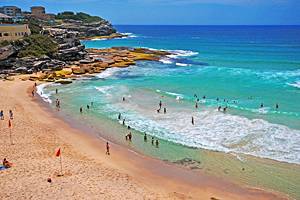
This website uses modern construction techniques, which may not render correctly in your old browser. We recommend updating your browser for the best online experience.
Visit browsehappy.com to help you select an upgrade.
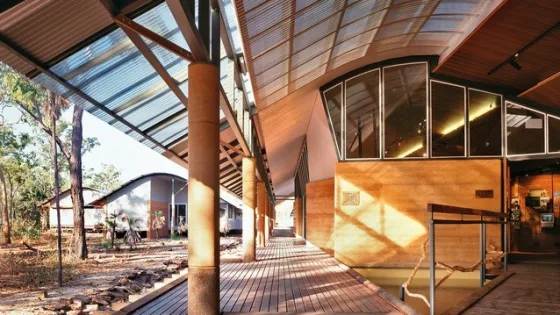
- Bowali Visitor Centre
- See & Do
- Attractions
Kickstart your Kakadu exploration and make a stop at Bowali Visitor Centre
Open year-round from 8am-5pm, Bowali is a focal point for travellers seeking information, guidance, and inspiration for their Kakadu adventure. Staffed by knowledgeable experts, the Bowali Visitor Centre offers comprehensive resources, including maps, exhibits, and interactive displays that provide valuable insights into the park's diverse ecosystems, Indigenous heritage, and unique flora and fauna. Whether you're a seasoned explorer or a first-time visitor, Bowali is a great starting point to your holiday, ensuring that every visitor is well-equipped to explore and appreciate the richness of Kakadu's landscapes and cultural significance.
Get Directions

Parks Access Report

- FB icon Follow us on Facebook
- insta icon Follow us on Instagram

Karrimanjbekkan An-me Kakadu - Taste of Kakadu 2024 is almost here! Part of the program is the opportunity to see Paul 'Yoda" Iskov from Fervor create incredible Fervor-style dishes using native ingredients collected on Country with Kakadu’s Traditional Owners. Image of "long yam' from @fervorfood

Great news - Cahills Crossing is open! An iconic experience and one of Kakadu's best known crocodile spotting sites 🐊 Be sure to check the Kakadu Access Report which is updated daily. Image thanks to @big.lap.aus [IG]

Yekke Season (May to mid-June. 21°C – 33°C) is about to begin and is one of the 6 seasons of Kakadu. This is a relatively cool time with less humidity. Early-morning mists hang low over the plains and the shallow wetlands and billabongs are carpeted with water lilies. Dry winds and flowering Darwin woollybutt tell local Aboriginal people that it’s time to start patch burning to ‘clean the Country’ and encourage new growth. In Kakadu, park rangers and Traditional Owners work together using these cultural burning practices to protect land and Country. Kakadu’s Traditional Owners, the Bininj/Munguy, have used fire for generations as a management tool for practical and cultural reasons. Image: @parksaustralia

🥾🥾 NEW Cooinda Lodge Bush Tucker Tour Embark on an enlightening journey through the diverse botanical landscape of Kakadu with our knowledgeable in-house tour guide team. This walking tour delves into the indigenous bush tucker, uncovering the traditional uses of various local plants and their cultural significance to the Indigenous Bininj people. Tour guests will not only learn but also have the opportunity to taste these native flavours 🌱 Adults from $39 | Children 5-15 $9 Each tour departs from Cooinda Lodge, operating from 1st May to 31st October 2024. Minimum 4 people to run the tour, with a maximum of 30 people. To find out more, see our website: kakadutourism.com

🐊 There is over 10,000 crocodiles living in Kakadu National Park. In local language, crocodiles are called kingas (pronounced ging-us). Crocodiles 🐊 have vertical, slit-shaped pupils which become narrow in bright light and widen in darkness. This controls the amount of light that enters. Crocodiles have sharp vision during the day time ☀️, but they also have their own built-in night vision 🌙 Crocodiles can even see underwater 🌊. Their eyes have a special third eyelid known as the nictitating membrane. These eyelids are clear and protect their eyes while underwater. 📸 Images captured at Cahill's Crossing by @patroln_downunder #croc #crocodile #NTAustralia #Tourismopend #Northernterritory #Australia #dokakadu kakadu #kakadunationalpark #Wildlife #nature #naturephotography
Visit Kakadu
- About Kakadu
- Where to Stay
- Build My Itinerary
- Media & Blog
Stay Connected
Exclusive specials and announcements!

© Copyright 2023 - 2024 Kakadu Tourism
- Terms & Conditions
site by Karmabunny

IMAGES
COMMENTS
Things to Do in Kakadu National Park, Australia: See Tripadvisor's 15,048 traveler reviews and photos of Kakadu National Park tourist attractions. Find what to do today, this weekend, or in May. We have reviews of the best places to see in Kakadu National Park. Visit top-rated & must-see attractions.
Kakadu offers visitors a unique opportunity to connect with country and culture through tours and activities. It is a natural wonderland - 20,000 sq kms of outdoor adventure, Indigenous exploration, dramatic vistas and unhurried days.
Things to Do in Kakadu National Park, Australia: See Tripadvisor's 15,025 traveller reviews and photos of Kakadu National Park tourist attractions. Find what to do today, this weekend, or in May. We have reviews of the best places to see in Kakadu National Park. Visit top-rated & must-see attractions.
Three hours' drive from Darwin, Kakadu offers many experiences: bush walking, bird watching, cruising and swimming under waterfalls to four-wheel driving, camping, scenic flights and wandering through galleries of Aboriginal art 20,000 years old. Here are 10 of Kakadu's must-do activities. 1. Walk through ancient shelters at Nourlangie.
Kakadu Tourism is Indigenous owned, and is the largest collection of facilities catering to tourism in Kakadu. ... Top attractions in Kakadu that you must see! Plan your trip by viewing a collection of top attractions within Kakadu National Park including ancient rock art sites, waterfalls, swimming holes, cultural experiences, wildlife ...
Hike up the rocky and rugged plains of Nawurlandja. (Image: Tourism NT/Jewels Lynch) 3. Swim at Maguk. Best for: Active and adventurous traveller seeking off-the-beaten-path experiences. Of all the things to do in Kakadu, a swim at Maguk is one of the more under-the-radar activities, despite being absolutely stunning.
Top Things to Do in Kakadu National Park, Australia: See Tripadvisor's 15,144 traveller reviews and photos of Kakadu National Park tourist attractions. Find what to do today, this weekend, or in December. We have reviews of the best places to see in Kakadu National Park. Visit top-rated & must-see attractions.
When to visit. Experience the magic of World Heritage-listed Kakadu National Park on an outback adventure that defies expectation. In Australia's biggest national park you'll find rugged escarpments, lush rainforest and rock art galleries up to 20,000 years old. Learn about Aboriginal culture from Traditional Owners, the Bininj/Mungguy people ...
Jim Jim / Twin Falls region. The highlight of Kakadu are these two waterfalls - Jim Jim and Twin Falls Gorge. 19. Jim Jim Falls. Jim Jim Falls is a stunning waterfall located in the southern region of Kakadu National Park. The falls can only be accessed by 4WD vehicles and require a short hike to reach.
From here, you are perfectly based to explore the following attractions in Kakadu National Park…. 1. Yellow Water Billabong Cruise: A Journey Through Kakadu's Wetlands. The mist floats above the water as the sun gently rises casting a soft yellow and pink glow over the billabong.
The dry season is the most popular (and arguably the best) time to hit up Kakadu, with most of the attractions open and free from the big floods that come through in the wet.
1. Bushwalk Through Kakadu National Park. Tourism Australia/Nicholas Kavo. Access: Mixture of 2WD and 4WD depending on the trail. One of the most rewarding things to do in Kakadu is to find a quiet walking trail and spend the afternoon exploring!
Located only an hours' drive south of Cooinda and is accessed off of a 14 kilometre 4WD track off Kakadu Highway. See full details. See ways to experience (3) 7. Gunlom Waterfall Creek. 351. Waterfalls. One of the most picturesque waterfalls in Kakadu National Park.
Kakadu & Surrounds 3-day itinerary. Kakadu & Surrounds. Make the most of your 3 days to experience the diversity and beauty of Kakadu National Park. Follow expert guides to discover ancient local Aboriginal art. Get up close and personal with the largest reptile on the planet and learn about native wildlife on a river cruise.
Discover millennia-old Aboriginal rock art as you explore Australia's biggest reserve. In Australia's Northern Territory, rugged and remote Kakadu National Park is so vast that its various ecosystems contain natural wonders not found elsewhere within its borders. Rocky escarpments are showered with cascading waterfalls, and sinewy lakes ...
8. Gunlom Waterfall Creek. 351. Waterfalls. One of the most picturesque waterfalls in Kakadu National Park. Climb the stairs to the pristine plunge pools at the top of the waterfall with an infinity view of the park, or swim under the cascading waterfall at the base with a sandy beach and clear waters.
Bushwalker reading map. Kakadu is one of the largest national parks in Australia, covering a staggering 20,000 sq km. With that much land to cover, and so many out-of-this world sights to take in, planning your trip can be confusing. Our itineraries have been designed by people who live and work in Kakadu, and have helped thousands of visitors ...
Covering nearly 20,000 square kilometres, Kakadu National Park is a World Heritage listing renowned for both its cultural and natural values. See breathtaking horizons from the top of a Kakadu escarpment. Cruise on the stunning Yellow Water Billabong to spot crocodiles and wildlife in their natural habitat, including millions of migratory birds ...
Embark on the ultimate outback adventure from the Mercure Kakadu Crocodile Hotel and Cooinda Lodge, with iconic attractions, tucker, tours and cultural experiences on your doorstep. Kakadu Tourism is Indigenous owned, and is the largest collection of facilities catering to tourism in Kakadu.
The park is one of the top attractions in Australia's Northern Territory, and it's one of the most popular places to visit from Darwin. Kakadu is huge. At almost half the size of Switzerland, it's the largest national park in Australia, with more than 20,000 square kilometers of rivers, monsoon forests, mangroves, tropical woodlands, wetlands ...
Flowering of Darwin Woolly Butt also convey that it is time to start burning the woodlands in patches to 'clean the country' and encourage new growth for grazing animals. This is when Kakadu icons such as Maguk, Jim Jim and Twin Falls begin to open for tourist. Kakadu Tourism is Indigenous owned, and is the largest collection of facilities ...
One of Kakadu's lesser-known attractions, Maguk is a pristine natural waterfall and plunge pool at the base of steep gorge walls. Read more . Kakadu & Surrounds ... Disclaimer: Tourism NT provides product listings to facilitate tourism operators and consumers connecting and booking products or services directly with each other. Tourism NT ...
Kickstart your Kakadu exploration and make a stop at Bowali Visitor Centre. Open year-round from 8am-5pm, Bowali is a focal point for travellers seeking information, guidance, and inspiration for their Kakadu adventure. Staffed by knowledgeable experts, the Bowali Visitor Centre offers comprehensive resources, including maps, exhibits, and ...